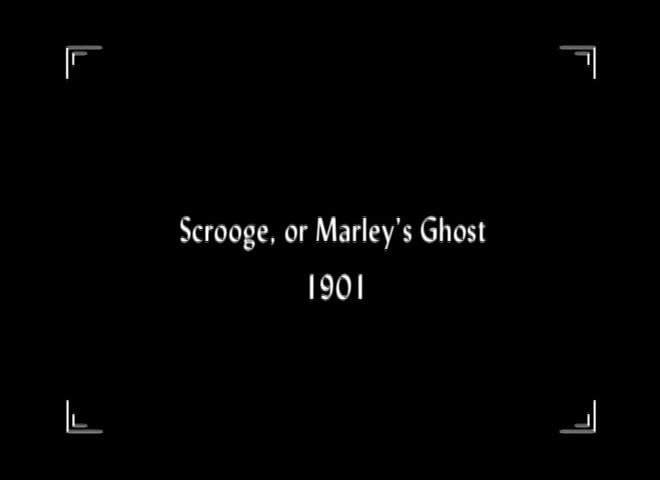Charles Dickens' Literary Influence on Cinema Told Through Cigarette Cards
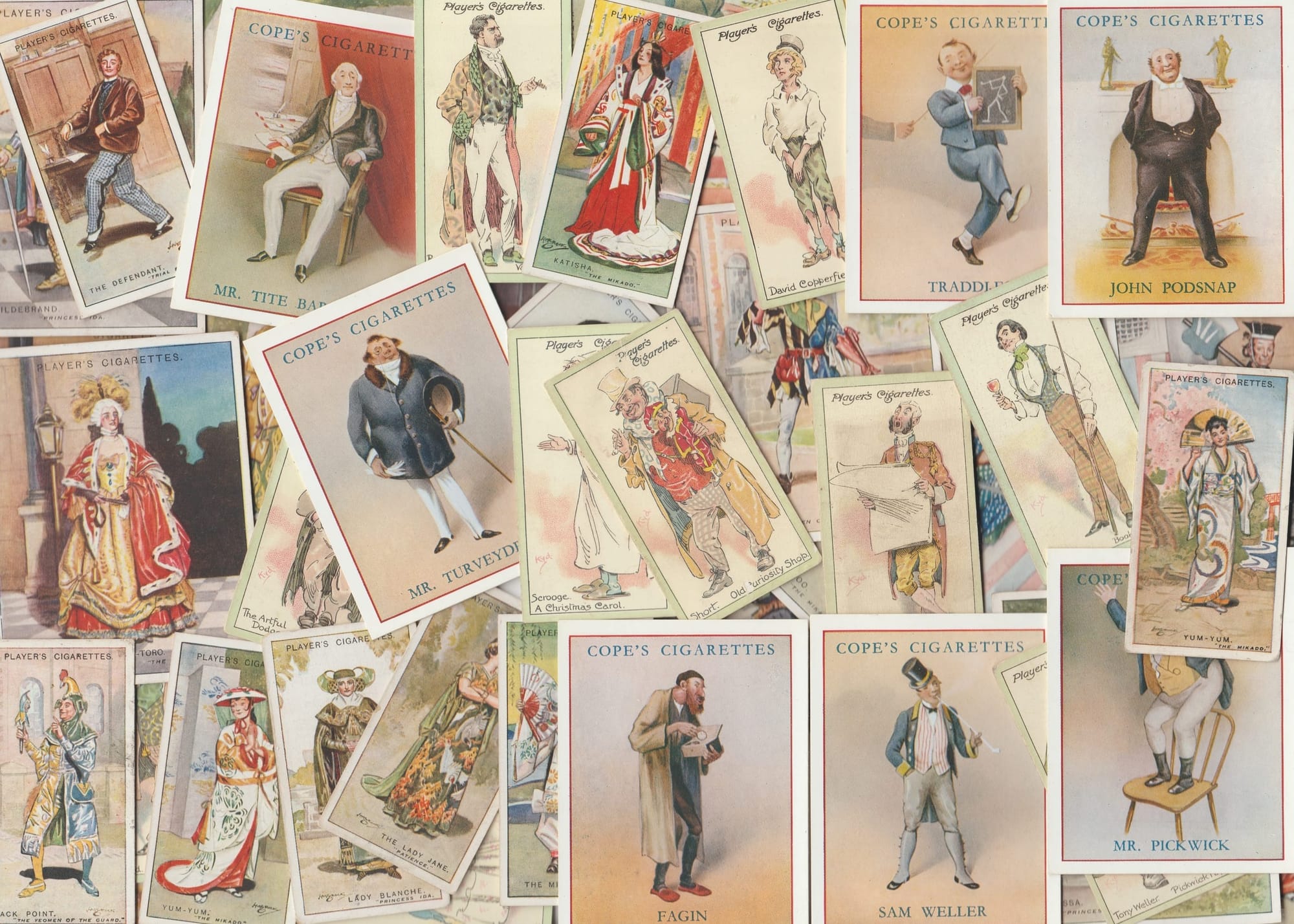
The works of authors such as Charles Dickens, William Makepeace Thackeray, Jonathan Swift, the duo Gilbert and Sullivan and many others have had a lasting impact on film production. This article explores how their characters, also immortalized in the series of cigarette cards, have influenced cinema and popular culture. Imagine this scene: we are in the early 1900s, you are settling down for a night at the cinema, perhaps enjoying a cigarette, and opening the package you find a mini-portrait of Oliver Twist. Crazy, right? Maybe not so much when you consider how famous these authors were at the time.
The influence of classical literature on cinema is a phenomenon that deserves an in-depth analysis. Film adaptations of literary works have a long history, reflecting cinema's ability to capture and reinterpret the complex narratives and multifaceted characters created by writers.
These authors, whose works have addressed social, moral and human issues, have provided an inexhaustible source of inspiration for filmmakers. Their works, rich in social criticism, psychological introspection and vivid characterization, have found new life on the big screen, allowing the stories to reach an even wider audience.
In this chapter we will specifically analyze Dickens' stories through the images that could be found in cigarette packs
The "cigarette cards" are an example of how popular culture has celebrated these literary characters, offering not only visual portraits but also narrative contextualizations. The 1912 and 1914 series of Player cigarettes, for example, featured detailed illustrations of Charles Dickens characters by Joseph Clayton Clark, better known as Kyd. These cards depicted figures such as Fagin, Mr. Pickwick, and Captain Cuttle with a wealth of detail that reflected the depth and complexity of their literary characters.
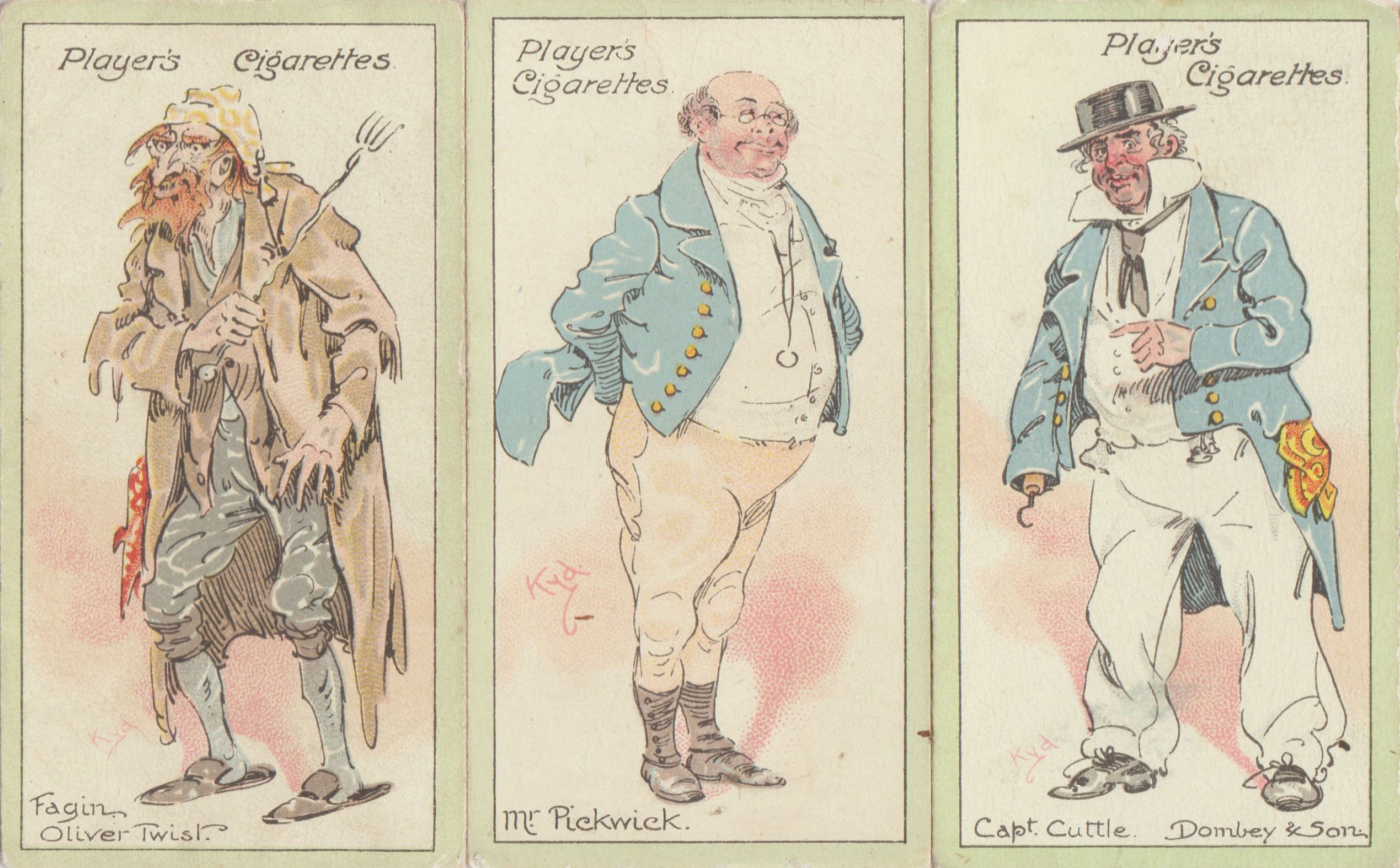
Cards n.2-16-25 della serie "CHARACTERS FROM DICKENS"
JOHN PLAYER & SON (1912)
(Personal collection)
"Scrooge, or, Marley's Ghost" from 1901 represents a milestone in the history of cinema, being one of the first film adaptations of a work by Charles Dickens. This silent short film, directed by Walter R. Booth and produced by Robert W. Paul, is known for being one of the earliest examples of the depiction of Dickens' stories on the big screen. The film, which is based on the 1843 novella "A Christmas Carol," was an ambitious undertaking for its time, trying to tell an 80-page story in just five minutes and using special effects that were impressive for the time, such as the superimposition of Marley's face on the door leaf and scenes from Scrooge's past projected onto a black curtain in his bedroom.
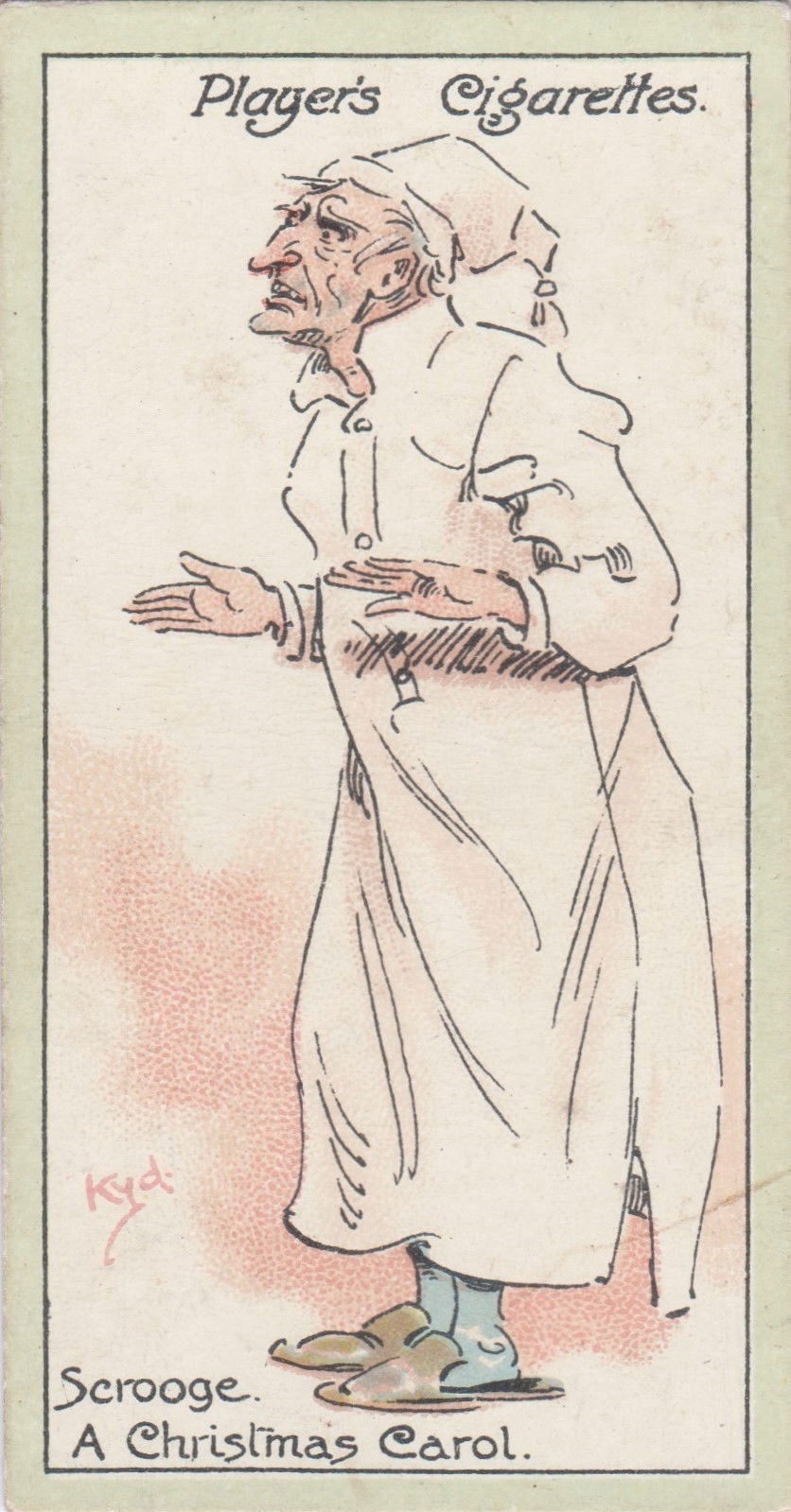
Card n.35 della serie "CHARACTERS FROM DICKENS" 2nd Series
JOHN PLAYER & SON (1912)
(Personal collection)
Prior to "Scrooge, or, Marley's Ghost", there had been few film adaptations of literary works. A significant example is "Sherlock Holmes Baffled" from 1900, a short film that lasts about 30 seconds and is considered one of the first films to feature the famous detective created by Arthur Conan Doyle. This film is known for being the first film adaptation of the character of Sherlock Holmes and for being considered the first known mystery film, especially for the inclusion of the character of Holmes.
These early adaptations, although short and experimental in nature, had a significant impact on the development of cinema, laying the foundation for future film adaptations of literary works. They proved that cinema could be a powerful medium for telling complex stories and paved the way for a long tradition of film adaptations that continues to this day. Their importance lies not only in their historical value but also in their ability to capture the essence of literary works and transform them into a visual format that could reach a wider audience, thus helping to spread classic literature and make it accessible to all.
The transposition of "A Christmas Carol" has a rich and varied history, reflecting the evolution of cinema itself. After the pioneering "Scrooge, or, Marley's Ghost" of 1901, Dickens' tale continued to inspire filmmakers. In 1908, the story was brought to the screen again, followed by a 1910 version that helped solidify cinema's role as a vehicle for complex narrative. With the advent of sound, 1938's "A Christmas Carol" offered audiences a more immersive experience, while subsequent interpretations explored new artistic and technological dimensions.
During the 1950s and 1960s, the adaptation of "A Christmas Carol" benefited from technological innovation, with films such as 1951's "Scrooge" taking advantage of color to add a new visual depth to the story. 1970 saw the birth of "Scrooge", a musical that introduced singing and choreographic elements to the interpretation of the novella. This trend towards innovation has been maintained in the following years, with adaptations that have included various interpretations and reworkings of the classic.
The 1984 adaptation, starring George C. Scott as Ebenezer Scrooge, marked a return to a more traditional approach, while the 1992 version featuring the Muppets introduced the tale to a new generation in a playful and original way. The late 20th century and early 21st saw a proliferation of different versions, including 1988's "Scrooged," which presented a modern, satirical take on the story, and the 2009 animated film starring Jim Carrey, which leveraged motion capture technology for innovative depiction.
Each adaptation of "A Christmas Carol" offered a new interpretation, reflecting the cultural and technological changes of its time.

CARD No. 5 from the FAMOUS PEOPLE series
LYONS MAID (1966)
The FAMOUS PEOPLE card series was distributed in 1966 by J. Lyons & Co. Ltd. of London. A card was included with Lyons Maid brand ice creams. The collection illustrates 48 cards and showcases the important figures of the nineteenth and twentieth centuries, of course Charles Dickens could not be missing
(personal collection)
These films not only kept Dickens' story alive, but also enriched cultural heritage, demonstrating cinema's ability to adapt and evolve. The tradition of film adaptations of "A Christmas Carol" continues to thrive, with new versions emerging regularly, each with its own unique perspective and artistic sensibility.
The OLD CURIOSITY SHOP
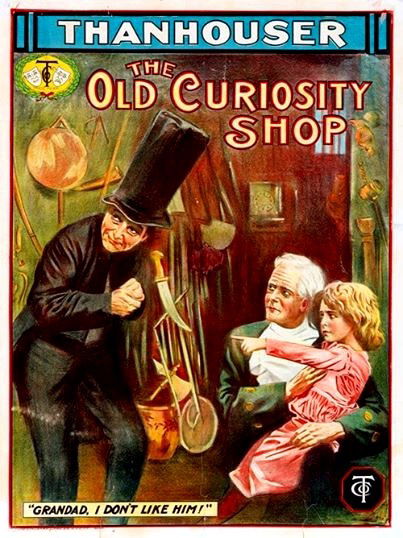
MOVIE POSTER
"The Old Curiosity Shop" from 1911 is another example of an early film adaptation of the works of Charles Dickens. This American silent film, directed by Barry O'Neil and produced by the Thanhouser Company, is based on the 1841 novel of the same name.
The film, lasting only one reel, focuses on the story of the grandfather who, due to gambling, falls into poverty, leading to the tragic death of his beloved granddaughter, Little Nell. Despite the limitations of the format, the film managed to capture the essence of Dickens' story, demonstrating respect for the source material and the ability to adapt complex literary narratives into short cinematic representations.
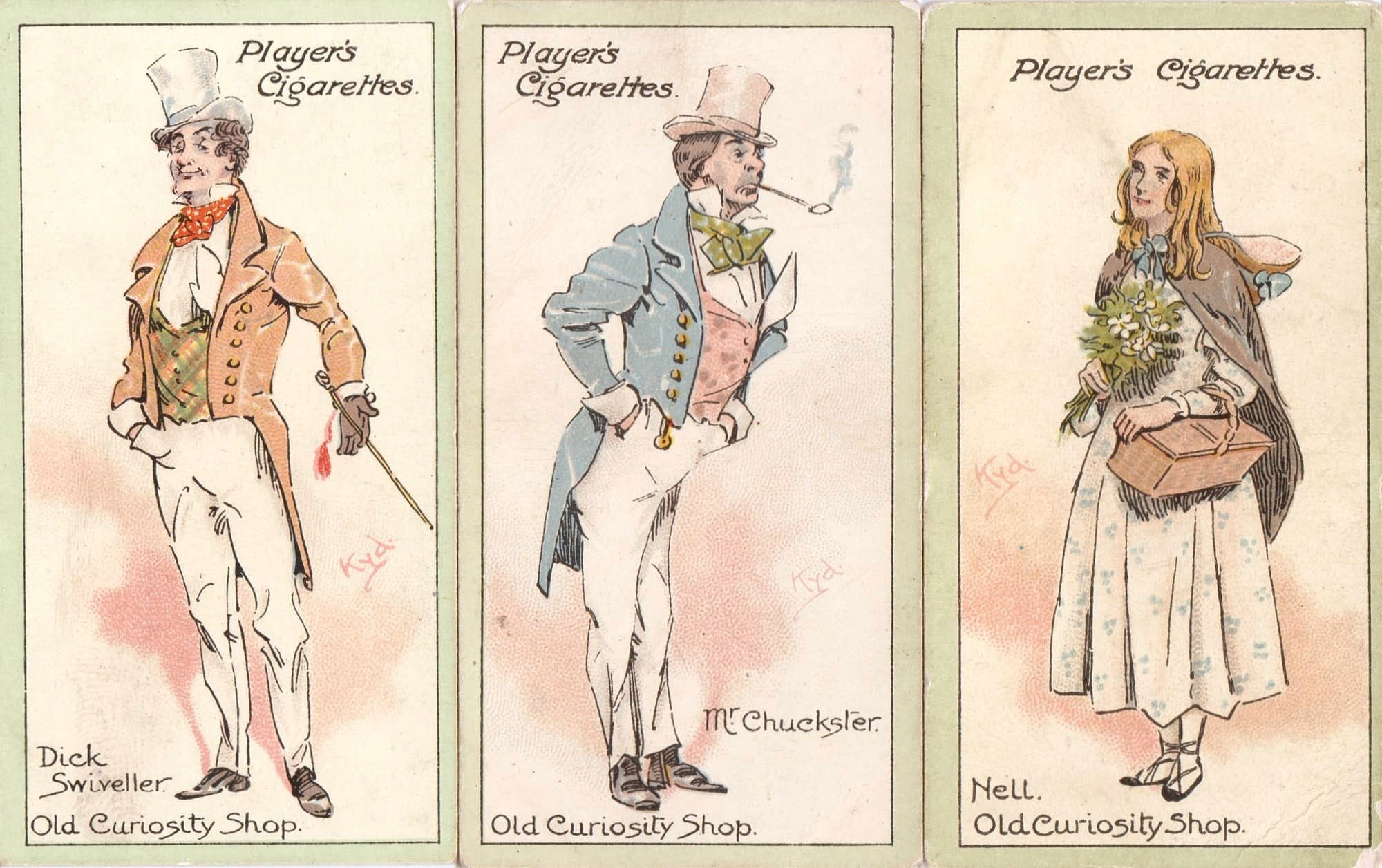
Cards n.11-12-22 della serie "CHARACTERS FROM DICKENS"
JOHN PLAYER & SON (1912)
(Personal collection)
"The Old Curiosity Shop" is significant not only for its fidelity to the original text, but also for the way it helped to establish a bridge between literature and cinema, a theme that we have also seen to be central to the cigarette card series.
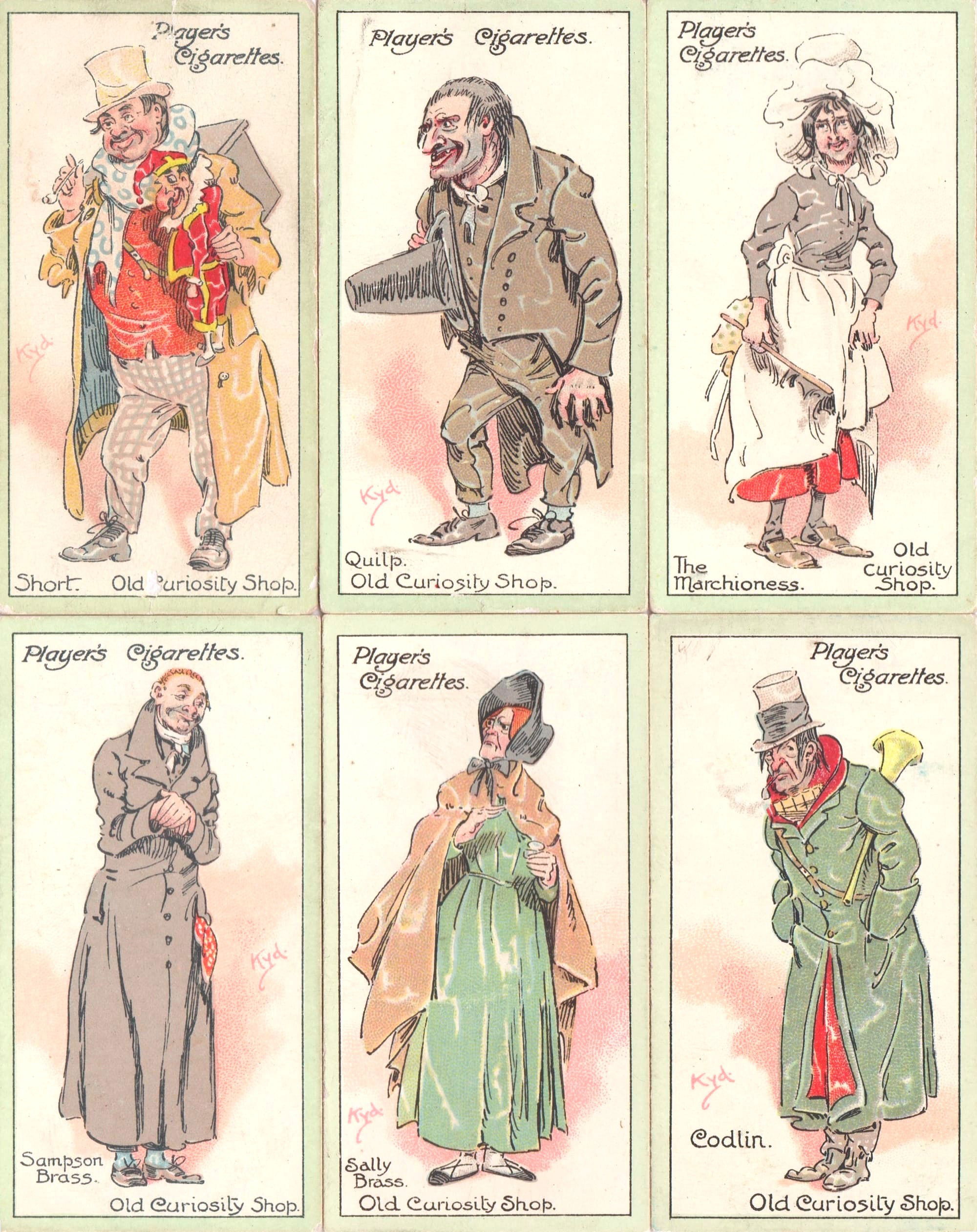
Cards dalla n.26 alla n.31 della serie "CHARACTERS FROM DICKENS" 2nd Series
JOHN PLAYER & SON (1912)
(Personal Collection)
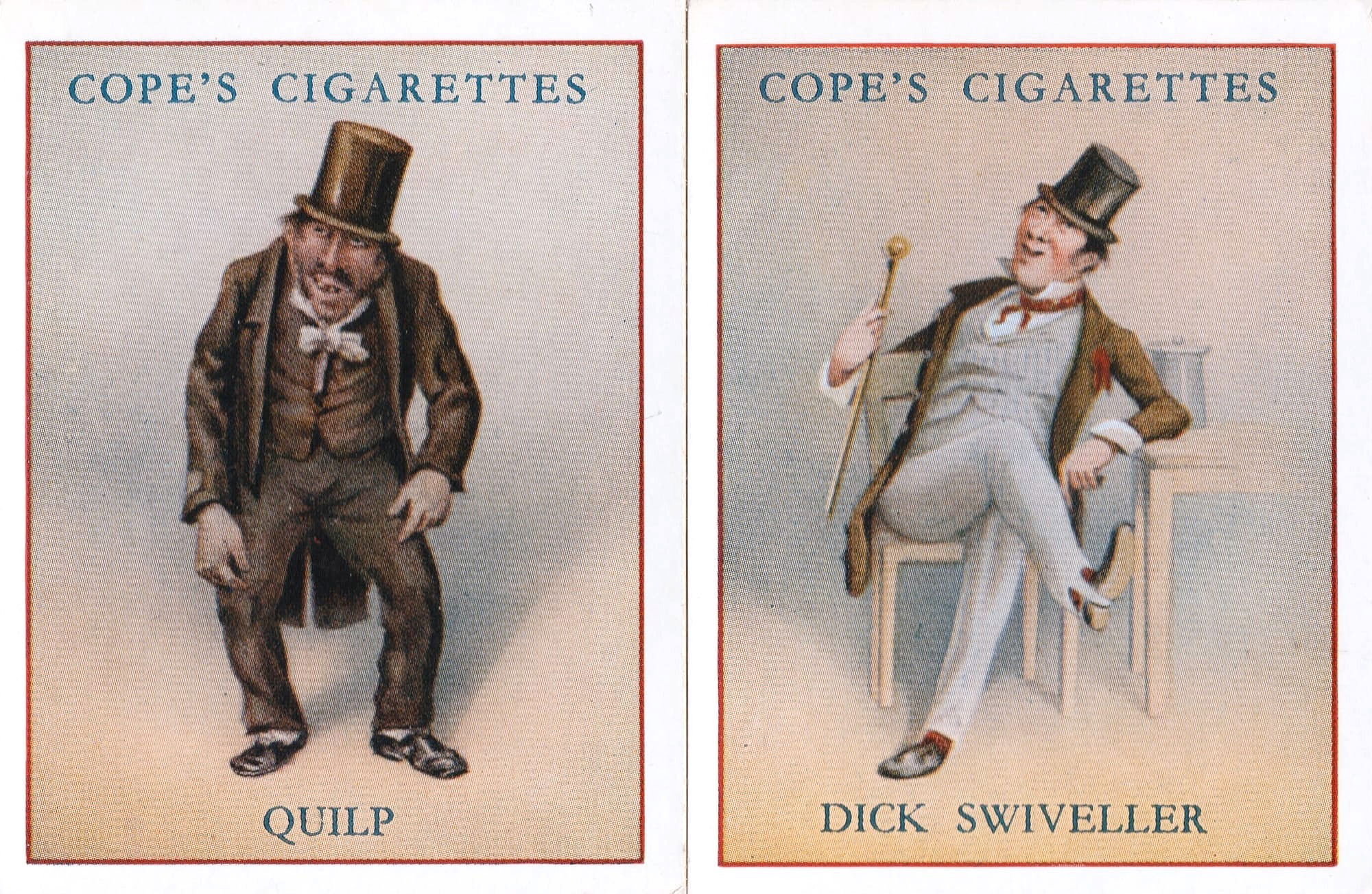
Cards n.17 e n.18 della serie "DICKENS CHARACTERS SERIES "
COPE'S CIGARETTES (1939)
(Personal collection)
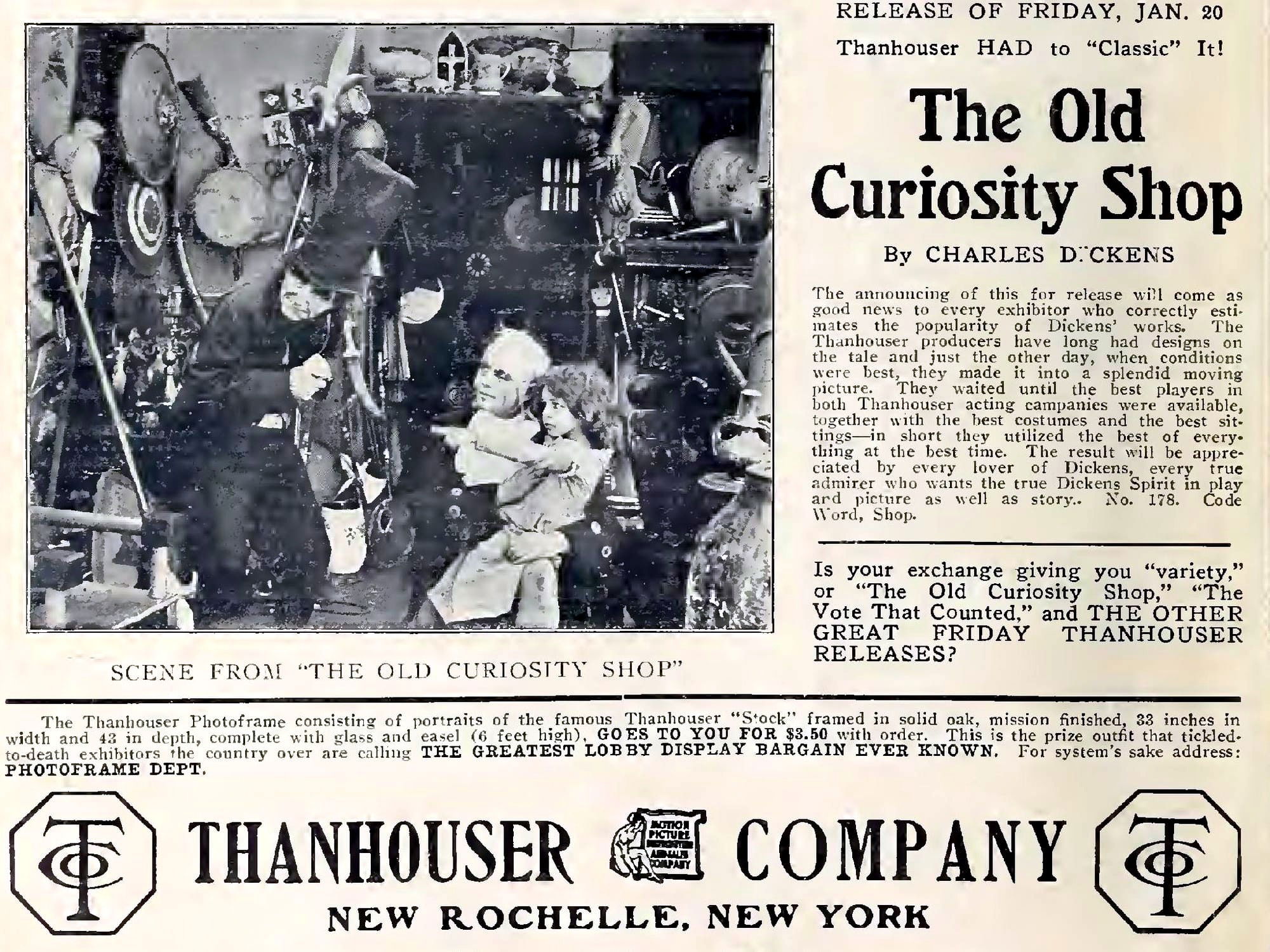
Moving Picture News (Friday, January 20, 1911)
This article highlights how the film was considered an important cinematographic transposition of Dickens' work, destined to appeal to lovers of literature and cinema of the time.
OUR MUTUAL FRIEND
In 1911, the Edison Company produced a silent film called "Eugene Wrayburn", based on the character of the same name in Charles Dickens' novel "Our Mutual Friend". This novel, published between 1864 and 1865, is the last completed by Dickens and deals with complex themes such as money and its influences on personal relationships.
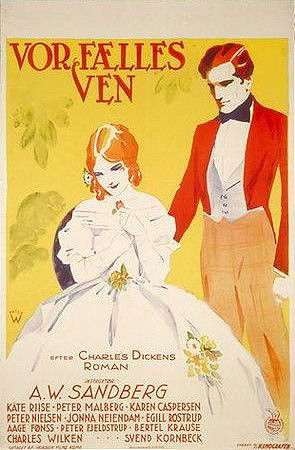
MOVIE poster (1921)
Ten years later, in 1921, Denmark produced another film adaptation of the novel, entitled "Vor fælles Ven". Directed by A.W. Sandberg, this film follows the story of John Harmon, a man found dead in a river, and the mysterious circumstances surrounding his death. The film focuses on the main characters of the novel, including Eugene Wrayburn, Lizzie Hexam, and Bradley Headstone. Among my collection, I have a card depicting John Podsnap, a character from "Our Mutual Friend". Podsnap is known for his arrogance and moralistic attitude, characteristics that Dickens used to criticize the society of his time.

Card n.25 della serie "DICKENS CHARACTERS SERIES
"COPE'S CIGARETTES (1939)
(Personal collection)
Despite his prominence in the novel, John Podsnap does not appear in either the 1911 or 1921 silent films. Both adaptations focus primarily on the dynamics between the main characters, leaving out many of the novel's secondary characters. However, the presence of Podsnap in Cigarette Cards demonstrates the enduring influence of Dickens' characters in popular culture.
MARTIN CHUZZLEWIT
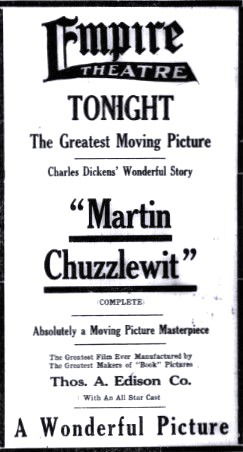
"Courtesy of the Media History Digital Library"
Advertisement for the film Martin Chuzzlewit in the Honolulu Star-Bulletin, December 19, 1912
excerpt from page 8 The Moving Picture World
The short film "Martin Chuzzlewit" from 1912 represents a significant example of early silent cinema, a time when the language of cinema was still finding its form. Directed by Oscar Apfel and J. Searle Dawley, the film is an adaptation of the novel of the same name by Charles Dickens, an author known for his social criticism and the psychological depth of his characters.
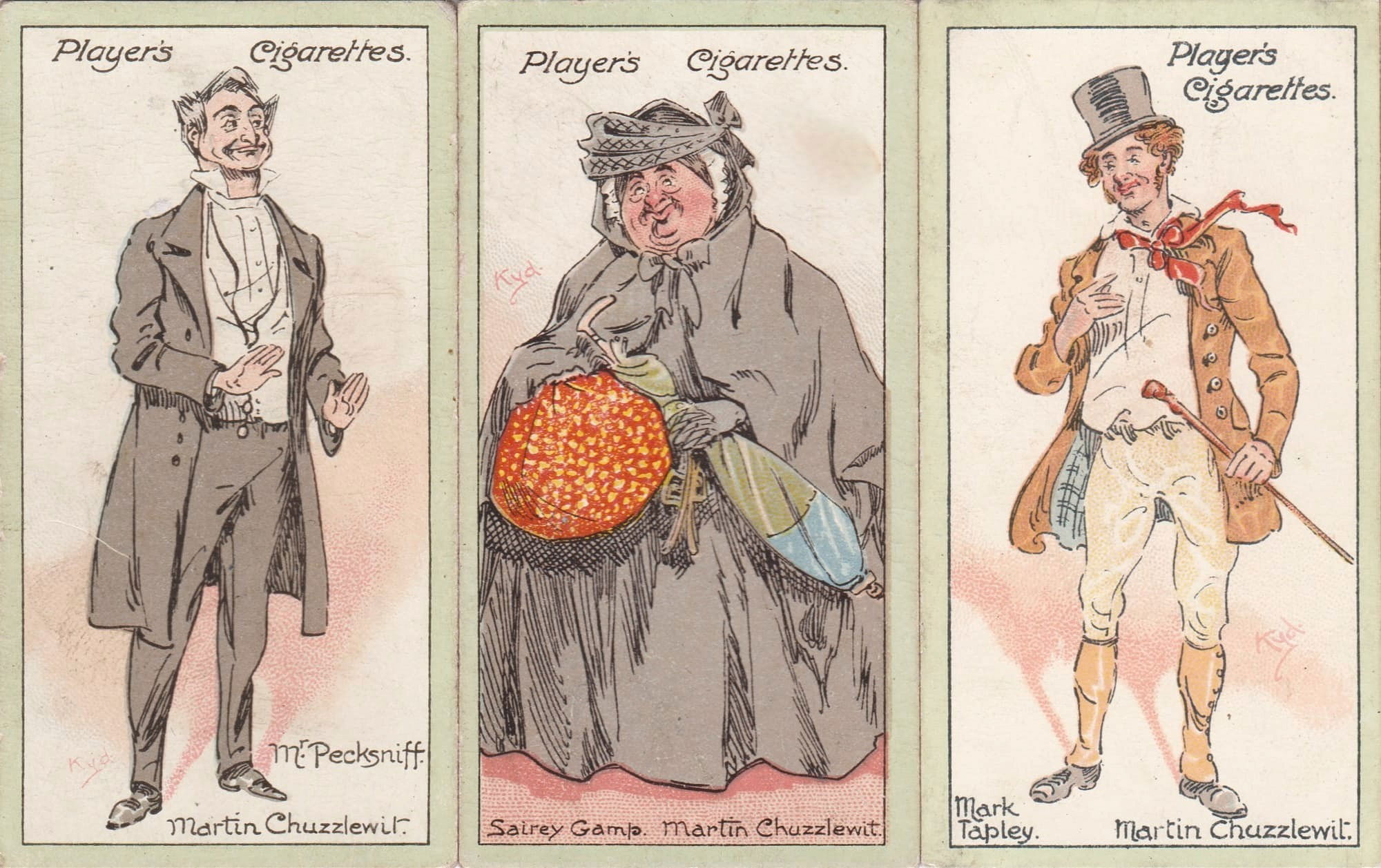
Cards n.23 and 24 of the series "CHARACTERS FROM DICKENS" and Card n.34 of the second series
JOHN PLAYER & SON (1912)
(Personal collection)
The production of this film by the Edison Company and its release through the General Film Company on June 10, 1912, reflect the importance of the emerging film industry in the United States of America in the early twentieth century. The choice to transpose into images the story of Martin Chuzzlewit, a young man surrounded by greedy and selfish relatives who aspire to his legacy, highlights the tendency of the time to explore universal themes such as greed and morality through the new medium of the film.
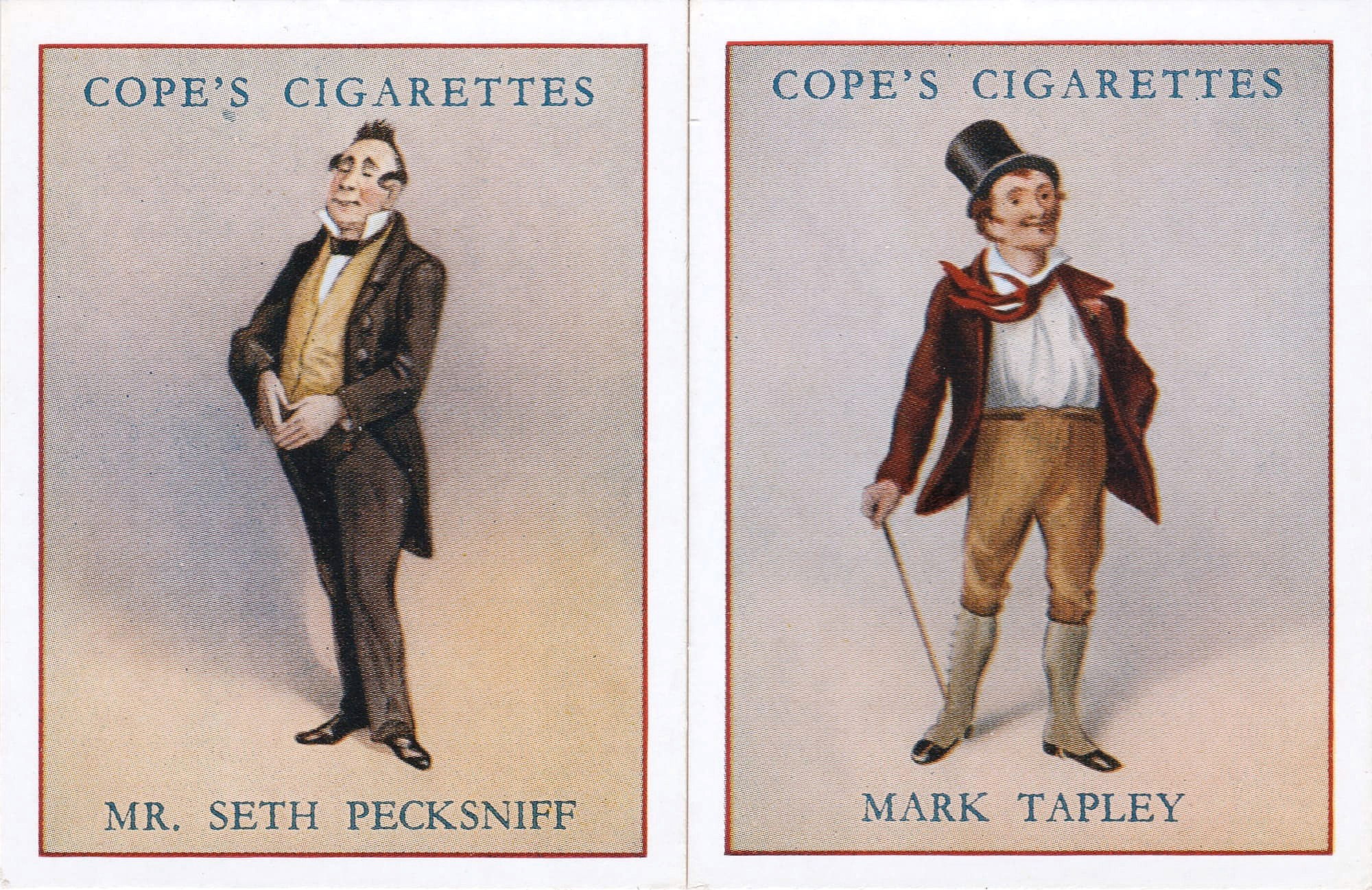
Cards n.12 e n.13 della serie "DICKENS CHARACTERS SERIES
"COPE'S CIGARETTES (1939)
(Personal collection)
The cast, which included actors such as George Lessey, Bessie Learn and Charles Ogle, helped bring the complexity of Dickensian characters to life, despite the technical limitations of the time that did not allow the use of sound. This short film not only provided audiences at the time with an immersive viewing experience, but also laid the groundwork for future generations of film adaptations of literary works.
The PICKWICK PAPERS

Card dalla n.15 della serie "CHARACTERS FROM FICTION"
JOHN PLAYER & SON (1933)
(Personal Collection)
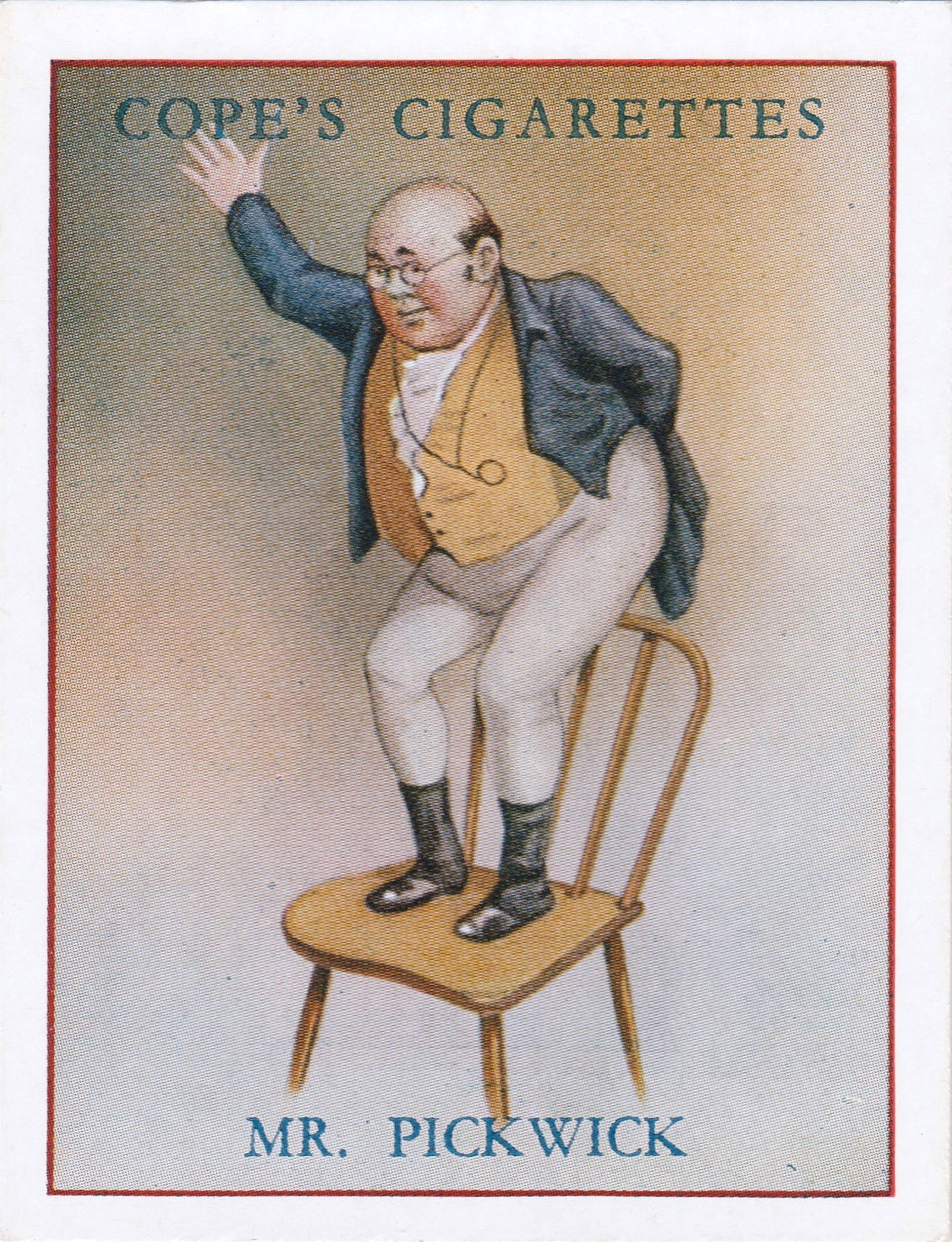
Card n.14 "DICKENS CHARACTERS SERIES "
COPE'S CIGARETTES (1939)
(Personal collection)
The Pickwick Papers (1913) is a silent film based on the 1837 novel of the same name by Charles Dickens. Produced by Vitagraph Studios, the film was directed by Laurence Trimble and stars John Bunny as Samuel Pickwick. The film consists of three reels, each representing a distinct episode from Dickens' novel. The titles of the reels are: "The Adventure of the Honourable Event", "The Adventure at the Westgate Seminary" and "The Adventure of the Shooting Party". In "The Honourable Event", Mr. Pickwick finds himself involved in a series of comedic events and misunderstandings, including an altercation with a carriage driver and a missed duel. "The Adventure at the Westgate Seminary" and "The Adventure of the Shooting Party" continue with other misadventures of the members of the Pickwick Club.

SAM AND TONY WELLER
"CHARACTERS FROM DICKENS" EXTRA LARGE
JOHN PLAYER & SON (1912)
(Personal Collection)
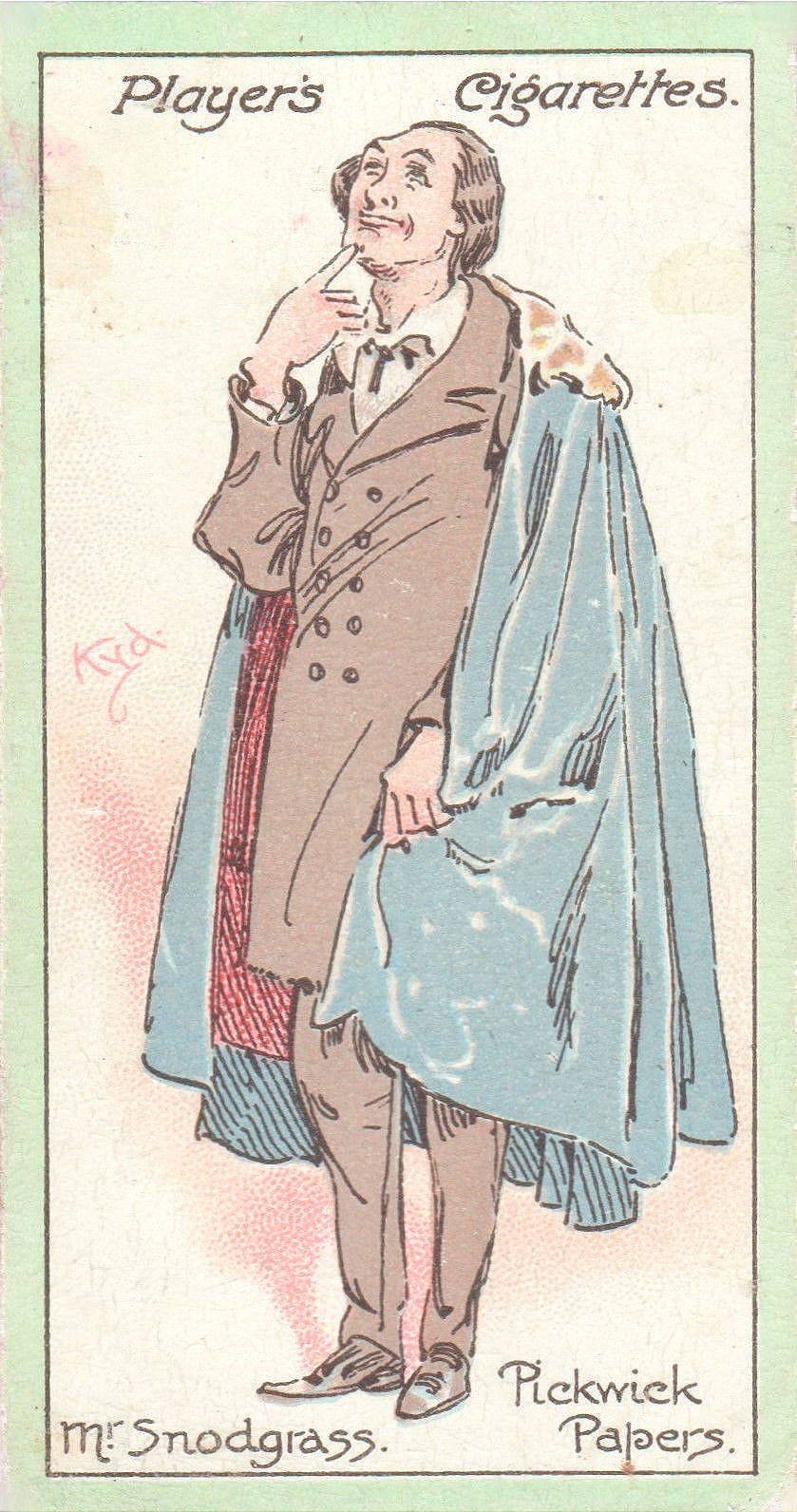
Card n.10 della serie "CHARACTERS FROM DICKENS"
JOHN PLAYER & SON (1912)
(Personal collection)
A little parenthesis about the artist who designed these beautiful JOHN PLAYER Cards:
Joseph Clayton Clark, better known by the pseudonym "Kyd", was a distinguished British artist born in 1857 and deceased on August 8, 1937. He is best known for his vivid illustrations of characters from Charles Dickens' novels. His artwork was disseminated through magazine publications or sold as stand-alone watercolors, rather than being incorporated into editions of Dickens' books.
Clark began his career as a freelance illustrator, and his first depictions of Dickens characters were published in 1887 in Fleet Street Magazine. Subsequently, two collections of his illustrations were released: "The Characters of Charles Dickens" in 1889 and "Some Well Known Characters from the Works of Charles Dickens" in 1892. His artistic interpretations were influenced by the original illustrations of Hablot Knight Browne, known as "Phiz", and Robert Seymour, however Clark developed his own distinctive style that earned him great admiration.
In addition to his work on Dickens, Clark produced humorous series such as "Some Typical Newspaper Readers" and "The Book and Its Reader." During the 1920s, Clark maintained his livelihood primarily through the sale of watercolor sketches depicting Dickens characters, marketed through booksellers in London.
His creations enjoyed great esteem among collectors of Dickensian memorabilia, so much so that a collection of 241 of Clark's watercolors was sold at auction at Christie's in 1890. Clark was also known for his somewhat eccentric lifestyle, often characterized by wearing gray suits, gloves and a carnation or other flower in his breast pocket.

Card n.13 della serie "CHARACTERS FROM DICKENS"
JOHN PLAYER & SON (1912)
(Personal collection)
The film was mainly shot in England, which was quite unusual for the time, as most Vitagraph films were shot in the United States. This was done to ensure an authentic setting, as desired by John Bunny. Distributed by the General Film Company, the film was released in US and UK theaters in February 1913.
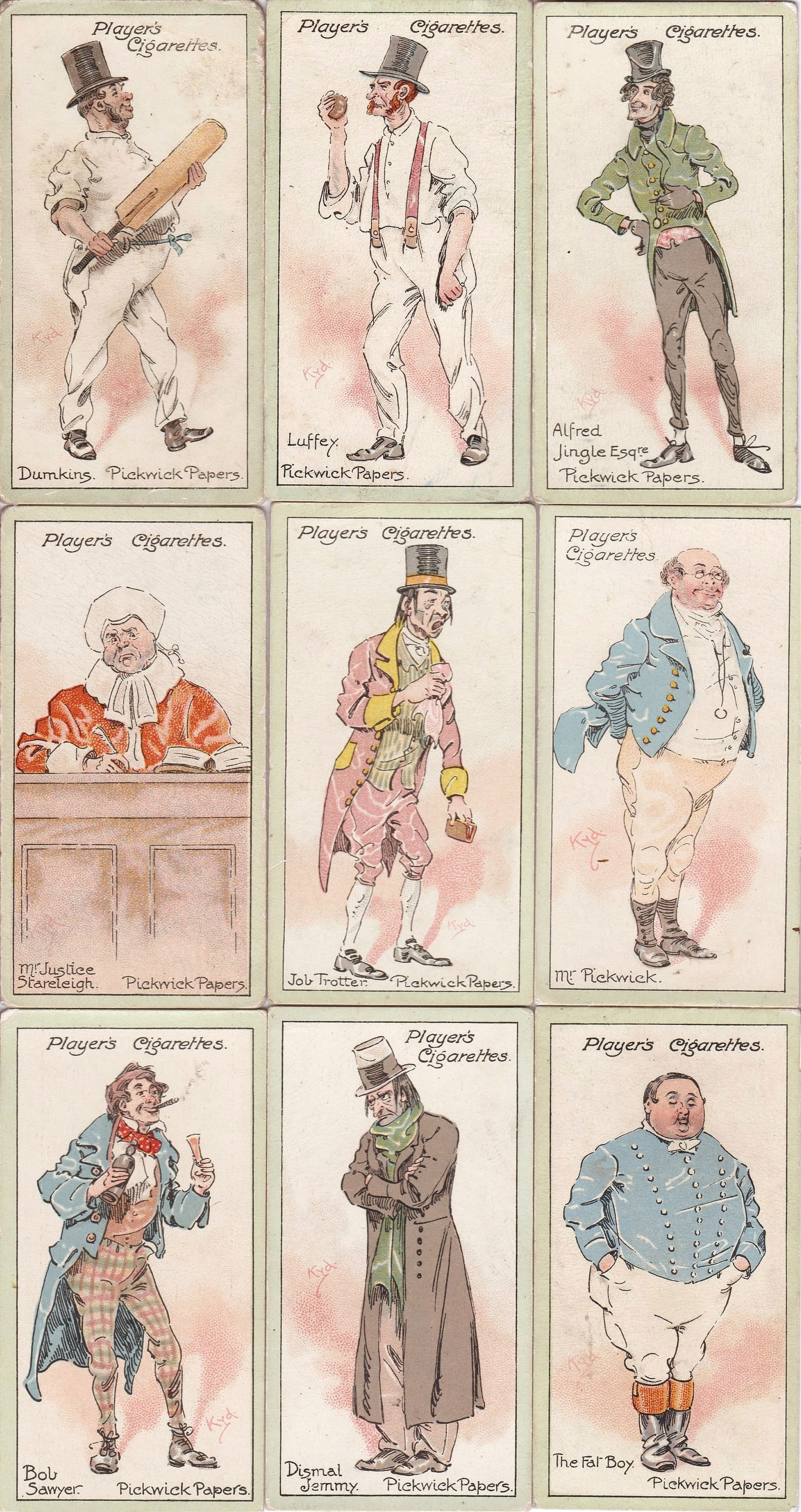
Cards n.5-6-8-14-15-16-19-20-21 della serie "CHARACTERS FROM DICKENS"
JOHN PLAYER & SON (1912)
(Personal Collection)
Despite its fidelity to Dickens' novel, the film was not a great success with the public, who preferred Bunny's one-reel comedies. Currently, only two reels of the film are preserved at the British Film Institute.
The cast includes John Bunny as Samuel Pickwick, James Prior as Mr. Tupman, Sidney Hunt as Mr. Snodgrass, Fred Hornby as Mr. Winkle, Arthur Ricketts as Mr. Jingle, H.P. Owen as Sam Weller, Minnie Rayner as Mrs. Budger, and Arthur White as Dr. Slammer. The film is one of the first film adaptations of a work by Charles Dickens. John Bunny, known for his comedies, considered this film to be one of his most important works.
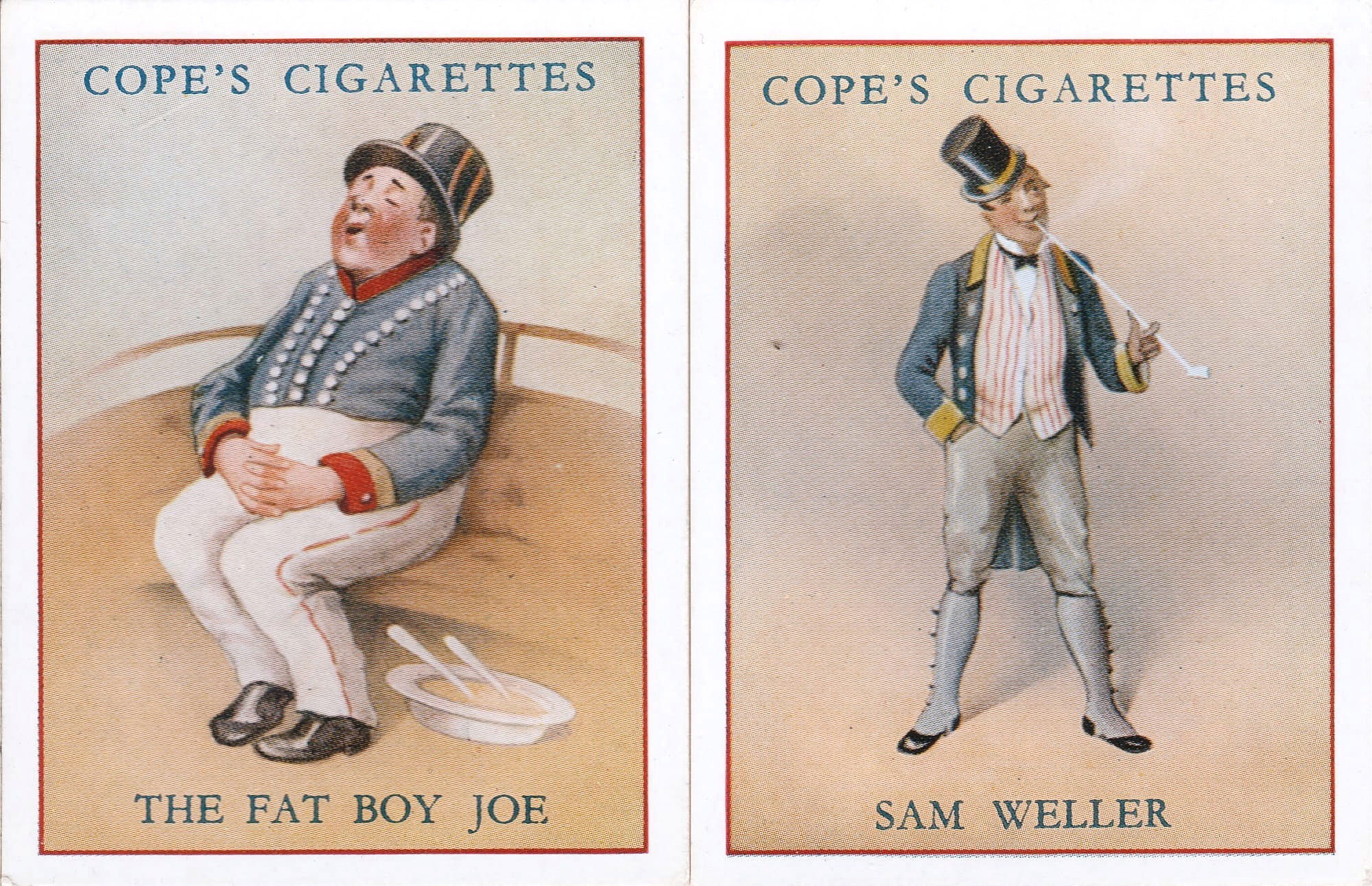

Cards n.15 e n.16 "DICKENS CHARACTERS SERIES "
COPE'S CIGARETTES (1939)
(Personal collection)
In 1916, the New York Sun listed The Pickwick Papers among a group of films that adapted classic literature for the big screen, arguing that such adaptations increased demand for their printed subjects and exposed many to literature they would not otherwise have known.
THE CHIMES
"The Chimes," one of Charles Dickens' five "Christmas Books," is a work that stands out for its profound exploration of humanity and redemption. Published in 1844, this novella follows the life of Toby "Trotty" Veck, a messenger who, crushed by the weight of poverty and social injustice, loses hope in humanity. The story takes place on New Year's Eve, a symbolic moment of end and new beginning, where Trotty is visited by spirits who lead him on a journey of self-discovery and renewal.

Card n.24 "DICKENS CHARACTERS SERIES "
COPE'S CIGARETTES (1939)
(Personal collection)
Through Trotty's eyes, Dickens takes us to a world where poverty is not a fault, but a condition often unjustly imposed by society. The spirits show Trotty that every person has value and that human goodness can triumph even in the most adverse circumstances. "The Chimes" is not only a story of hope and solidarity, but also a call to society to recognize and correct its injustices.
The impact of "The Chimes" extends beyond the pages of the book. The two 1914 film adaptations of Charles Dickens' "The Chimes," one directed by Herbert Blaché and the other by Thomas Bentley, offer distinct interpretations of the same story. Blaché's film, produced in the United States, features a narrative that emphasizes drama and class struggle, with Tom Terriss in the role of Trotty Veck, a character who embodies despair and hope for redemption. The American production focuses on Trotty's inner transformation, emphasizing his emotional journey through visions and dreams that lead him to reconsider his beliefs about society and poverty.
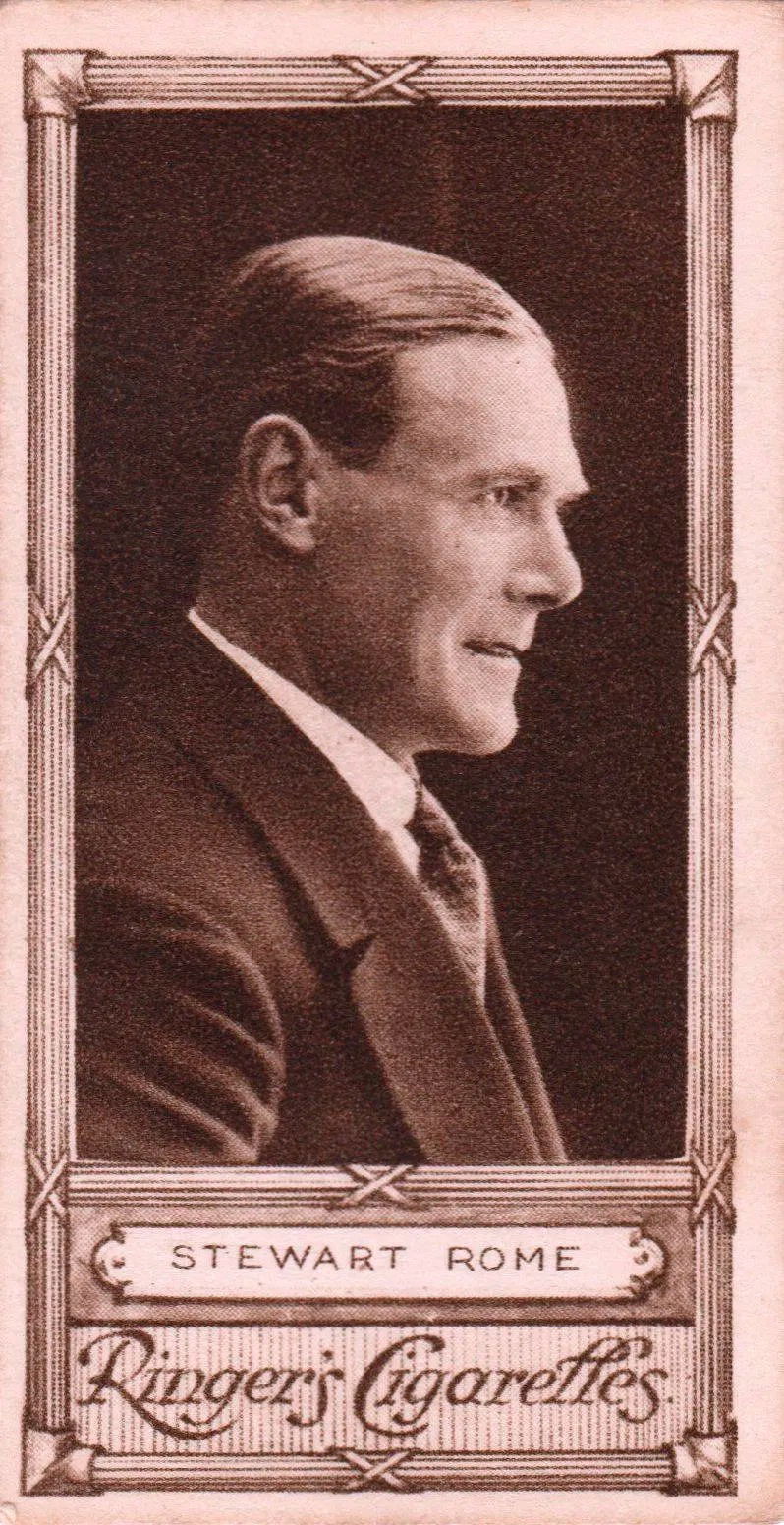
CARD n.42 CINEMA STARS
RINGER'S CIGARETTES (1923)
(Personal collection)
On the other hand, Bentley's adaptation, made in the UK, makes use of a script that is more faithful to the original text, with Stewart Rome playing Richard and Violet Hopson as Meg Veck. This British version places more attention on social details and secondary characters, enriching the narrative with nuances that reflect the complexity of Victorian society. Bentley's direction stands out for its ability to capture the atmosphere and environment described by Dickens, creating a deeper immersion in the author's world and themes. His 1914 film adaptations, both in the United States and the United Kingdom, helped bring Trotty's story and his message of redemption to a wider audience. These films, despite the technical limitations of the time, captured the essence of Dickens' novel, demonstrating that the themes dealt with are universal and timeless.
The relevance of "The Chimes" persists today, in an era when issues of social injustice and inequality are more relevant than ever.
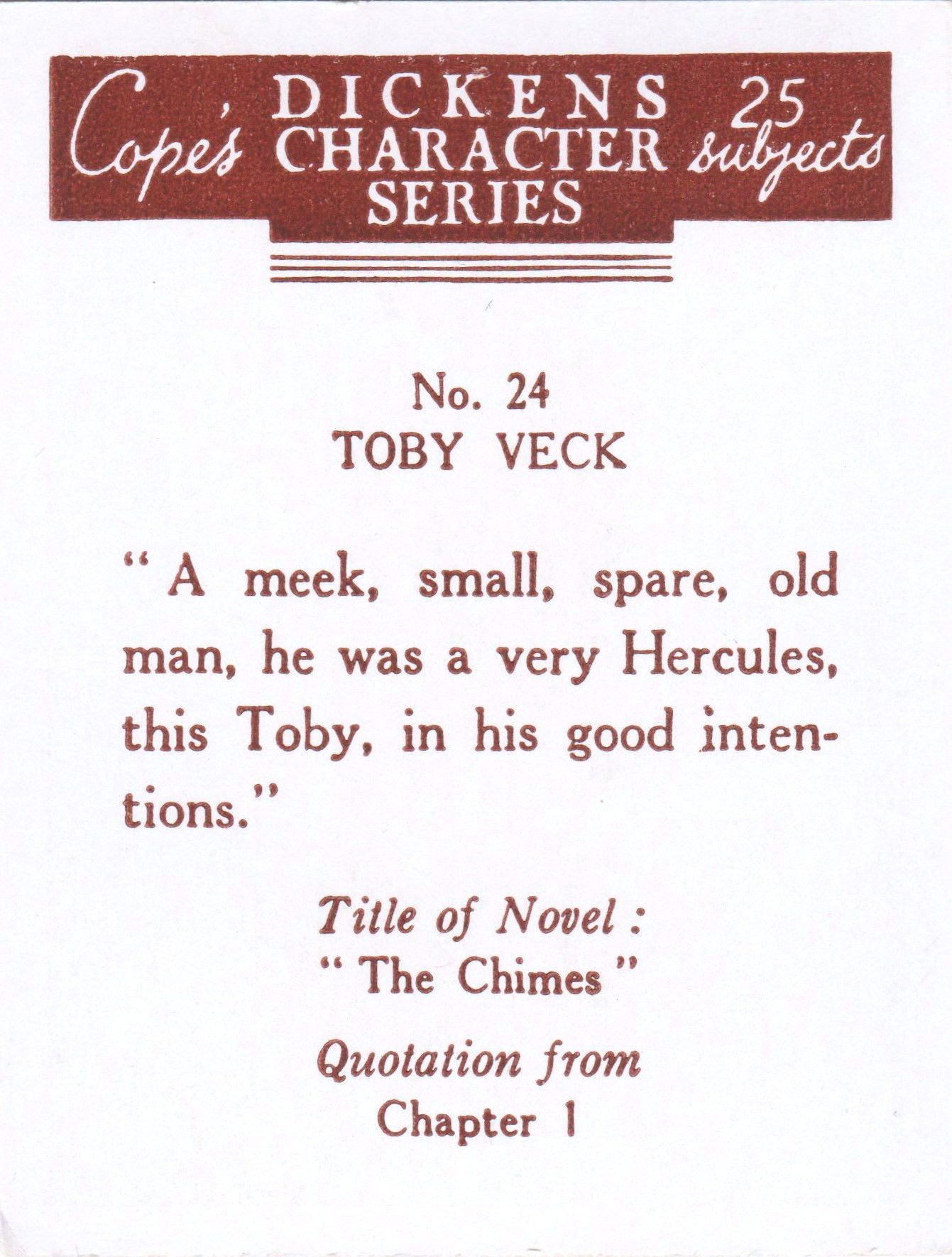
"A meek man, small, thin and old, this Toby was a true Hercules in his good intentions."
Retro Card n.24 "DICKENS CHARACTERS SERIES "
COPE'S CIGARETTES (1939)
(Personal collection)
Trotty Veck's story is a reminder that hope and kindness are powerful forces that can change the world, a message that continues to resonate powerfully in every generation. With its engaging narrative and memorable characters, "The Chimes" remains a timeless classic that inspires and challenges readers to reflect on their own humanity and the responsibilities we have to each other.
HARD TIMES
The silent film adaptation of Charles Dickens' novel "Hard Times" represents a significant artistic feat in the age of cinema. This film, made in 1915, is also a testament to silent cinema's ability to convey complex narratives and emotionally charged themes without the use of spoken word. The challenge of adapting such a rich and layered literary work into a dialogue-free visual format required special attention to the choice of actors, production design and direction to capture the essence of Dickens' message.
The story of "Hard Times", set in the industrial city of Coketown, explores the difficulties and injustices of life during the Industrial Revolution.
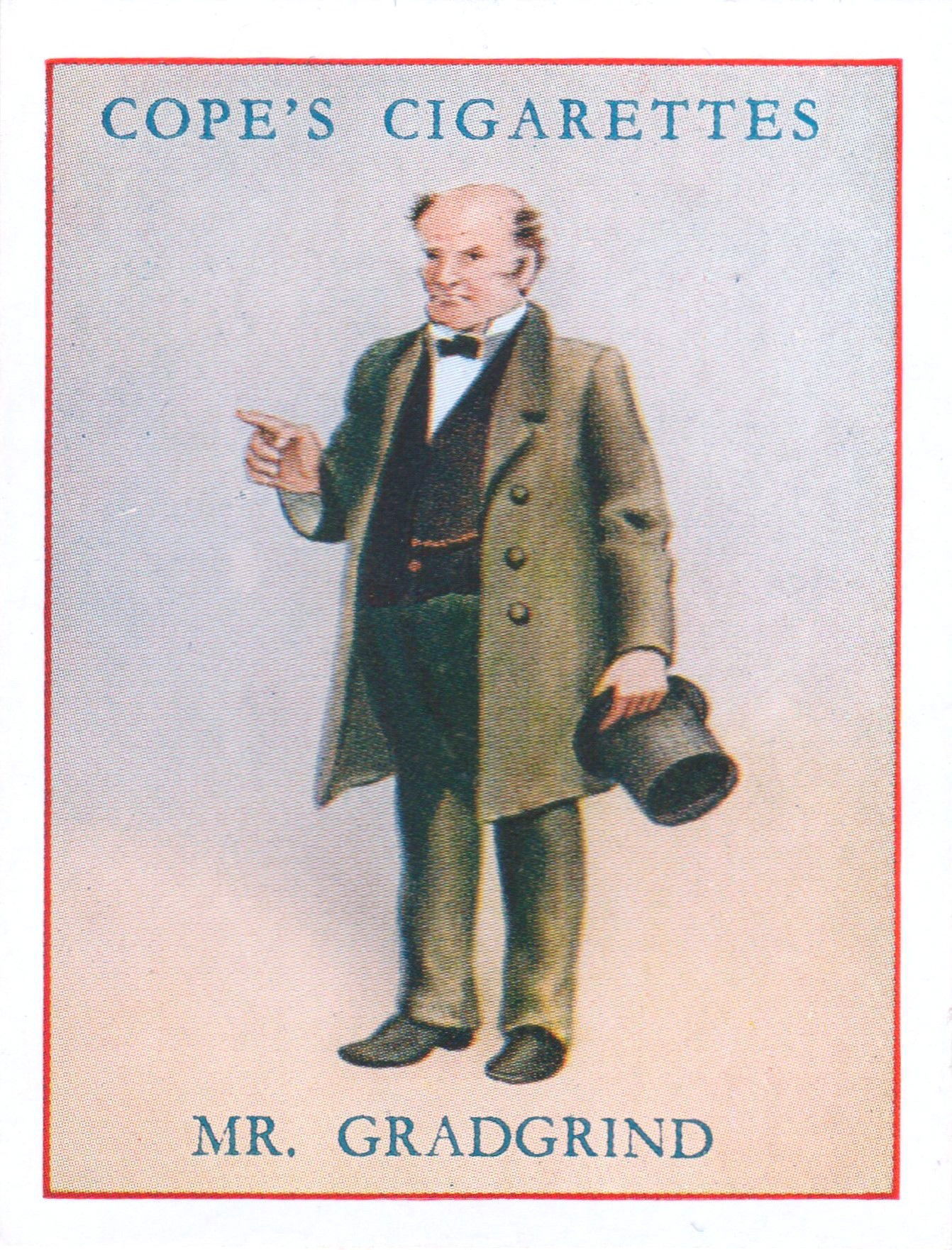
Card n.23 "DICKENS CHARACTERS SERIES "
COPE'S CIGARETTES (1939)
(Personal collection)
The silent film had to rely solely on facial expressions, gestures and intertitles to tell the story of Thomas Gradgrind, a man who preaches utilitarianism to his children, and Josiah Bounderby, an arrogant industrialist. The performance of the actors, therefore, took on a crucial role, as they had to convey the complexity of the characters and their interpersonal relationships without the support of dialogue.
The film's art direction was tasked with recreating the oppressive atmosphere of Coketown, with its steaming factories and streets crowded with workers. The sets had to evoke the harshness and monotony of working life, as well as the social distance between characters such as Gradgrind, Bounderby and the young Sissy Jupe, which represents innocence and fantasy in contrast to the surroundings.
The cinematography of the silent film "Hard Times" played a vital role in conveying the tone and atmosphere of the novel. The use of light and shadow, along with carefully composed shots, helped to create a sense of oppression and alienation that reflects the themes of the novel. In addition, the accompanying music, an essential element of silent cinema, had the task of underlining the emotions and narrative developments, guiding the viewer through the story.
Despite the limitations of silent cinema, the adaptation of "Hard Times" has shown that it is possible to convey powerful and complex messages through visual language. The film is an early example of how cinema can be used to explore social and human issues, a principle that continues to influence filmmakers to this day. The relevance of "Hard Times" as a silent film lies in its ability to connect the viewer with the struggles and hopes of the characters, demonstrating that Dickens' stories are timeless and that his critical spirit can be captured even without words.
An important note is on the director Thomas Bentley, who with his passion for the world of Dickens' characters, has given life to numerous transpositions of the works of this great writer.
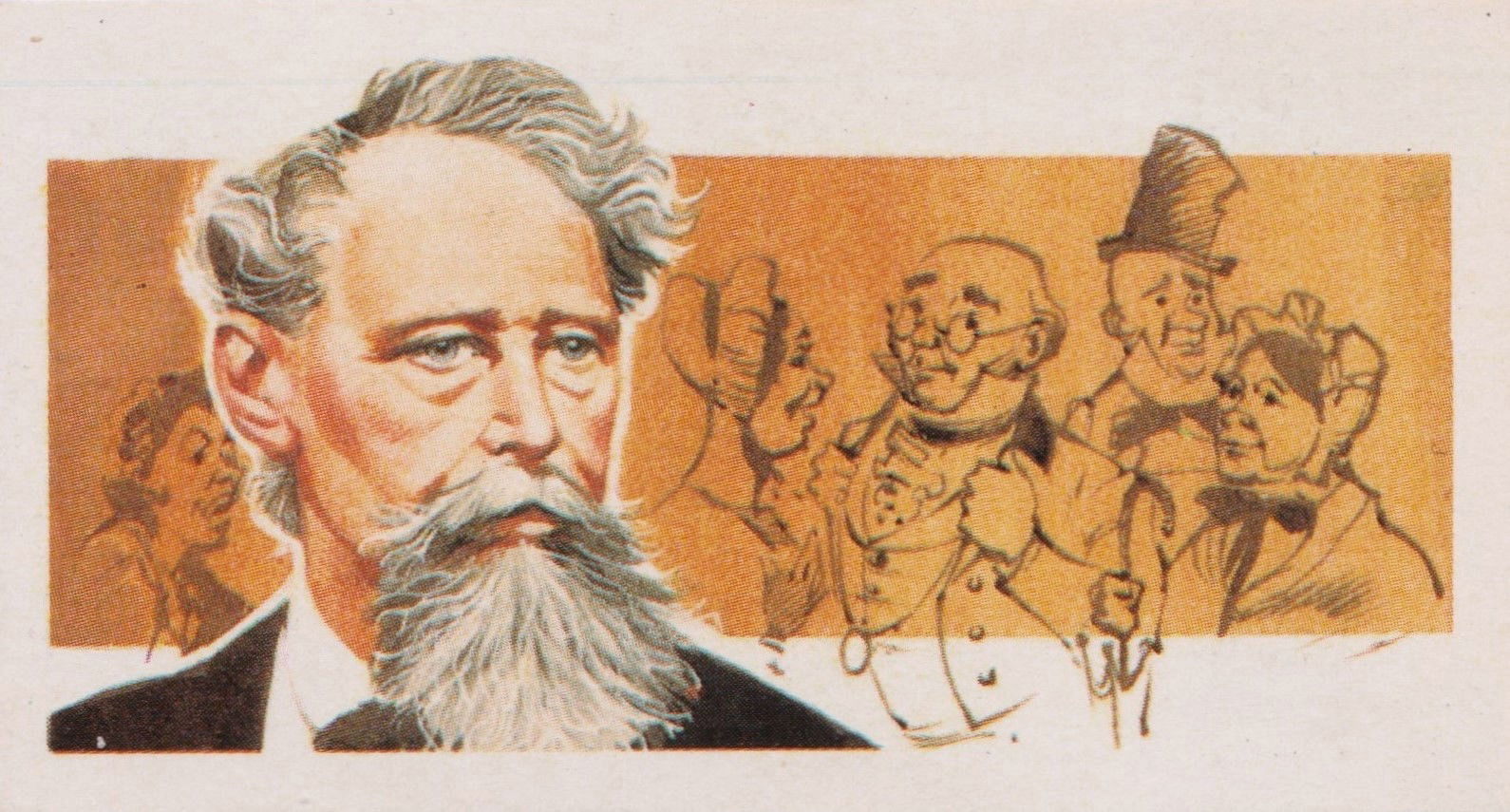
the "Famous People" series of cards by Brooke Bond Tea is a well-known collection. This series was published in 1969 and included 50 cards. Each card features a color illustration of a famous historical figure and a short biography on the back, here depicted Dickens with drawings of his most famous characters behind it.
CARD n. 6 della serie FAMOUS PEOPLE
BROOKE BOND TEA (1969)
(Personal collection)
His passion for Dickens was not accidental; before becoming a director, Bentley was a vaudeville artist who performed as Dickensian characters on stage. This theatrical experience profoundly influenced his approach to directing, allowing him to transfer the emotional complexity and social criticism of Dickens' novels to the screen with a unique sensitivity.
Bentley's career in film began in 1912, when Cecil Hepworth hired him to write and direct five adaptations of Dickens' novels. His directorial debut was with "Oliver Twist" in 1912, followed by a number of other films based on works by Dickens, including "David Copperfield" in 1913 and "The Old Curiosity Shop" in 1921. These films were pioneers in the art of film adaptation, proving that it is possible to capture the essence of complex literary narratives even without the use of the spoken word.
Bentley directed 68 films between 1912 and 1941, including three films in the DeForest Phonofilm sound process in the early 1920s. This period of transition from silent to sound saw Bentley experiment with new narrative and sound techniques, always maintaining a strong link with Dickens' stories. His ability to direct both silent and sound films demonstrates his versatility and his ability to adapt to technological changes in cinema.
After his retirement from directing in 1941, Bentley continued to contribute to the film industry as a technical adviser to the British Film Council. His legacy in the world of cinema was that of a craftsman of visual storytelling, a director who was able to transform Dickens' words into powerful and memorable images that have left an indelible mark on the history of cinema.
His interpretations of Dickens' novels were not limited to fidelity to the text, but sought to explore the social and human themes intrinsic to the stories, such as class struggle, social injustice, and redemption. Bentley was able to create films that not only entertained, but also stimulated reflection and dialogue on important issues, making Dickens' works accessible and relevant to a wider audience.
Thomas Bentley was not just a filmmaker, but a true innovator who was able to bring Charles Dickens' stories to life in a way that few others did. His dedication and talent helped define the art of film adaptation and make literary classics an inexhaustible source of inspiration for cinema. His works remain a point of reference for anyone approaching the art of transposing literature to the big screen.
BLEAK HOUSE
The 1920 film "Bleak House", directed by Maurice Elvey, represents an important cinematographic work in the field of silent transpositions of classic novels. Produced by Ideal Film Company, the film benefited from the participation of talents such as Constance Collier, who masterfully played the role of Lady Dedlock, Berta Gellardi as Esther Summerson and Helen Haye as Miss Barbary, all of whom helped bring Dickens' immortal characters to life.

ACTRESSES Series Card (B)
B. MORRIS & SONS LTD (1898)
(Personal collection)
Constance Collier embodied the role of Lady Dedlock in the 1920 film "Bleak House", a character that required an intense stage presence and remarkable expressive ability, especially in the context of silent cinema. Collier, with her interpretation, demonstrated an extraordinary talent in the art of wordless acting, managing to communicate the emotional complexity and depth of her character through gestures, looks and movements. His performance was acclaimed for its ability to convey a wide range of emotions, from pent-up passion to silent despair, contributing significantly to the film's emotional impact. Collier was able to capture the essence of Lady Dedlock, a high-society woman trapped in an unhappy marriage and marked by a mysterious past, bringing to the screen the complexity of a character struggling between social duty and personal desires. His performance is considered one of the most memorable in silent cinema and helped set a new standard for film acting at the time.
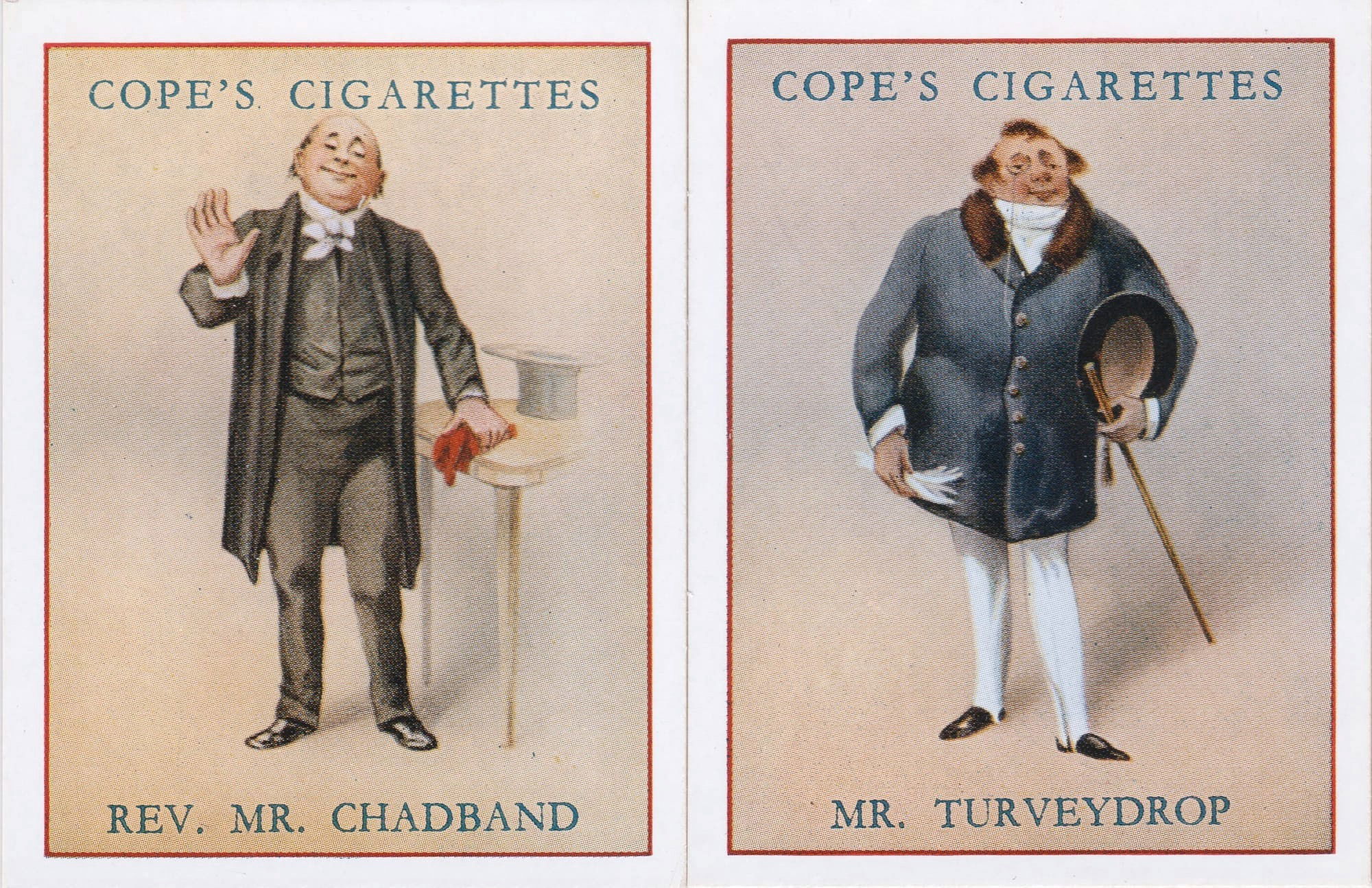
Cards n.6 e n.7 "DICKENS CHARACTERS SERIES "
COPE'S CIGARETTES (1939)
(Personal collection)
The exclusion of characters such as Mr. Chadband and Mr. Turveydrop from the 1920 film adaptation of "Bleak House" can be attributed to several practical and artistic reasons. First, the silent film format imposed significant limitations in terms of duration and narrative complexity. The filmmakers had to make selective choices to focus on the essential elements of the story, while ensuring a pace that could keep the audience's attention. Furthermore, the transposition of a literary work as dense and layered as Dickens' inevitably required a synthesis, and often the secondary characters, who do not directly influence the main plot, were omitted to make room for a more focused narrative.
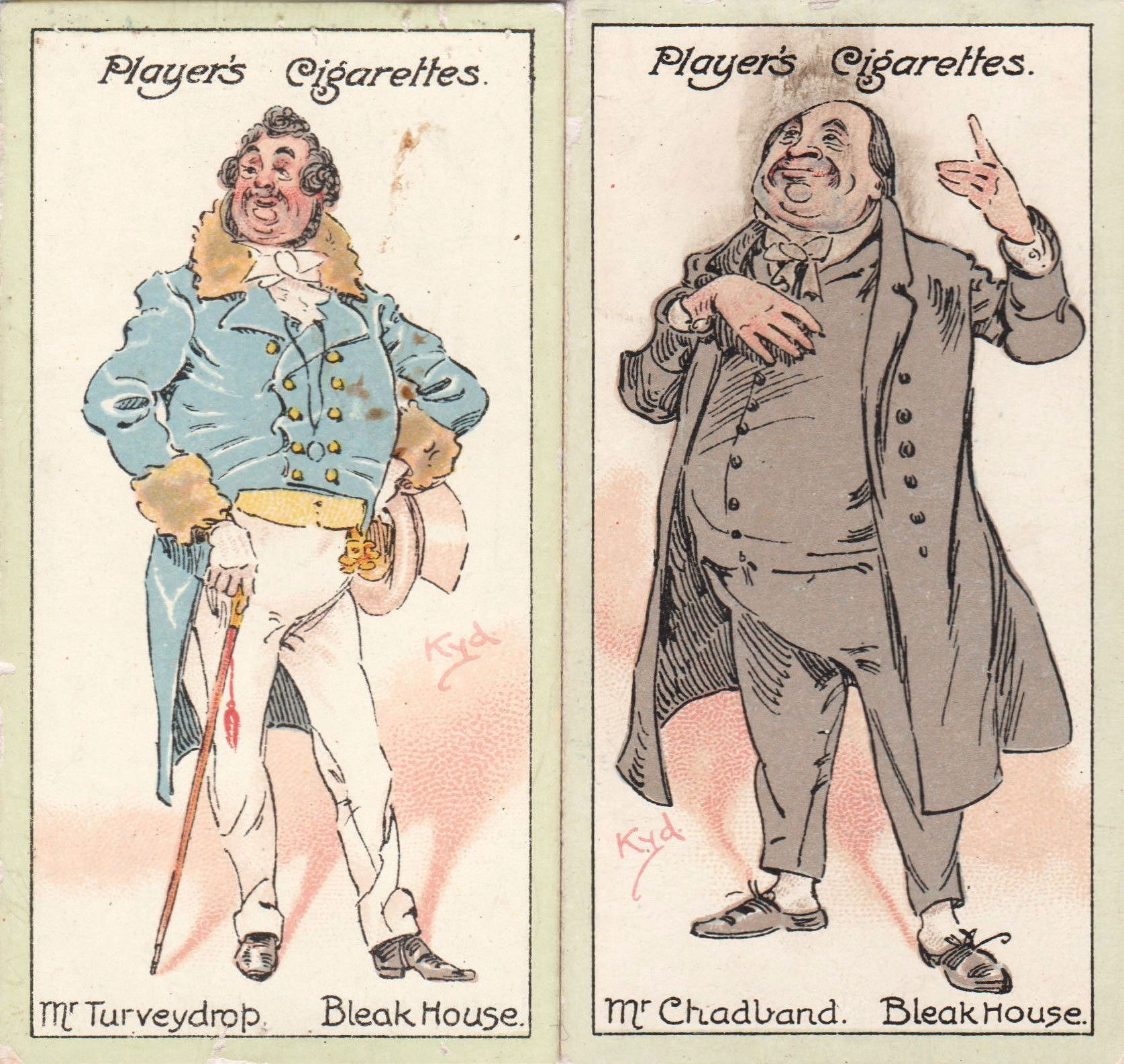
Cards dalla n.47 e n.50 della serie "CHARACTERS FROM DICKENS" 2nd Series
JOHN PLAYER & SON (1912)
(Personal collection)
Another aspect to consider is the visual representation of the characters. In silent cinema, without the support of sound dialogue, the characters had to be immediately recognizable and distinct through their stage presence and body language. Characters like Mr. Chadband and Mr. Turveydrop, who in the novel are characterized by a wealth of psychological nuances and meaningful dialogue, could have been less effective on screen without the possibility of using voice.
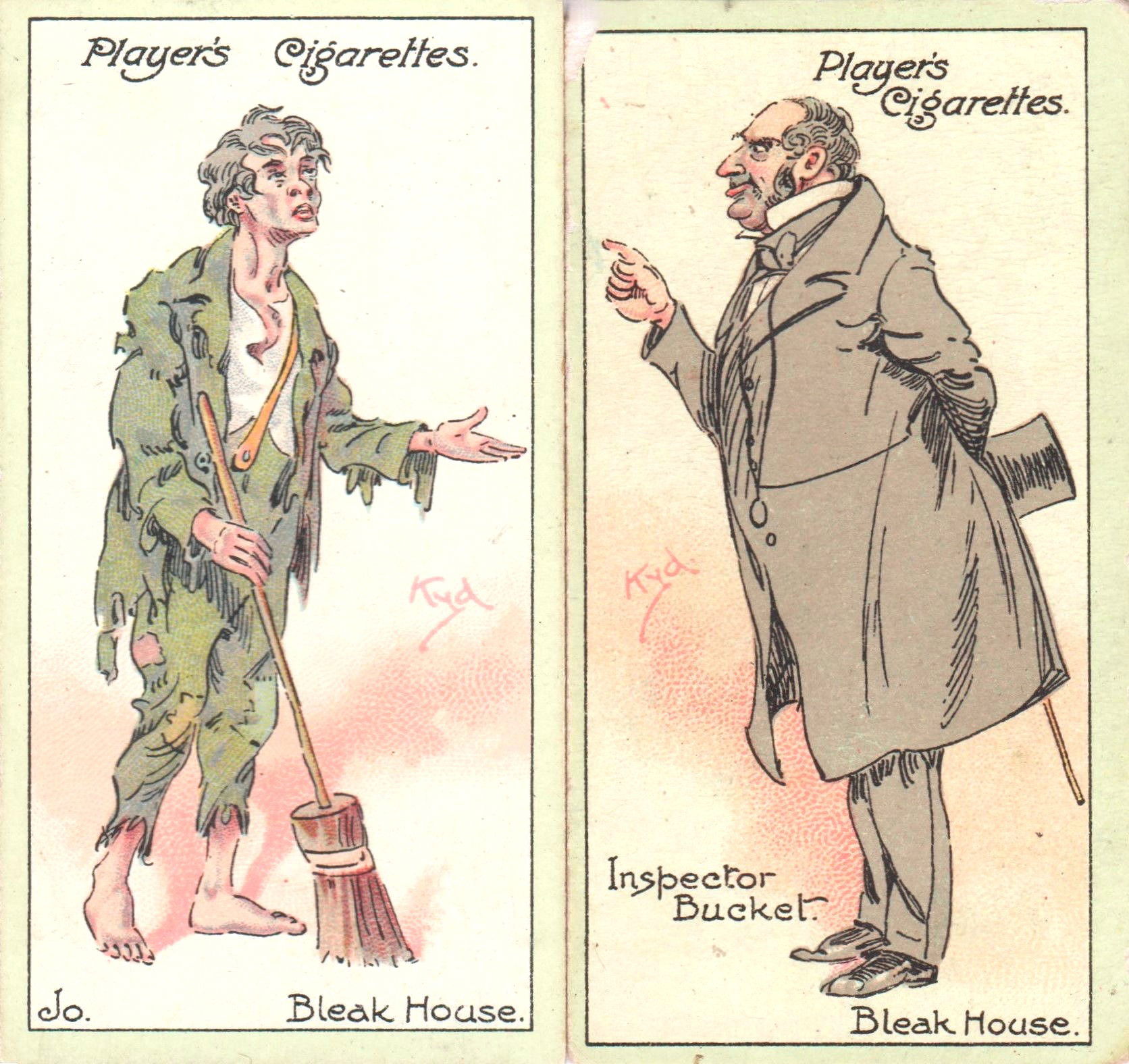
Cards dalla n.48 e n.49 della serie "CHARACTERS FROM DICKENS" 2nd Series
JOHN PLAYER & SON (1912)
(Personal collection)
The film's narrative remains faithful to the literary original, revolving around Jarndyce's complicated legal dispute against Jarndyce, a symbol of the corruption and inefficiency of the Victorian-era justice system. Through the lens of this legal battle, the film addresses issues of great relevance and emotional impact such as social inequality, morality and the possibility of redemption, recurring themes in Dickens' work and still of great resonance today.
The film overcomes the barriers imposed by silent cinema, managing to convey the profound essence of the novel with the help of evocative intertitles, intensely expressive acting and a direction that uses visual narration to compensate for the absence of sound dialogues. Constance Collier's performance is emblematic: her Lady Dedlock is an emotional tour de force that demonstrates how expressive power can be separated from the spoken word.
Maurice Elvey, with his direction, manages to capture and convey the oppressive atmosphere and narrative tension of the novel, offering viewers an immersive and reflective cinematic experience that echoes the social criticism inherent in Dickens' work. This film adaptation not only pays homage to the original text but also establishes itself as a reference point in the history of silent cinema, demonstrating how the seventh art can effectively interpret and rework complex literary works, leaving an indelible mark over time.
OLIVER TWIST
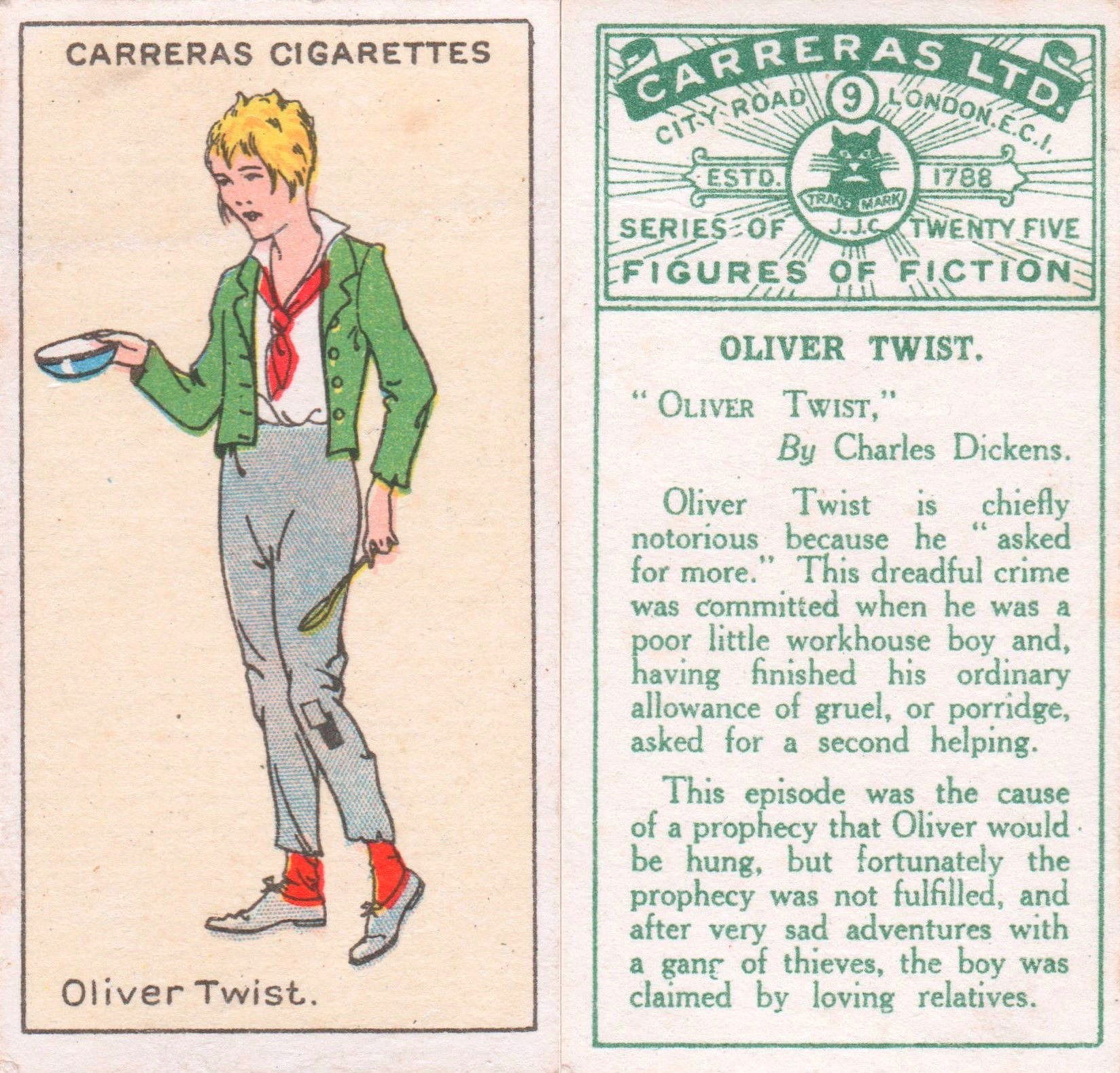
Cards n.9 "FIGURES OF FICTION"
CARRERAS LTD (1924)
(Personal collection)
The 1922 silent film "Oliver Twist", directed by Frank Lloyd, is one of the many film versions of Charles Dickens' novel of the same name, originally published between 1837 and 1839. This particular transposition is famous for the interpretations of Jackie Coogan in the role of Oliver and Lon Chaney in the role of Fagin.
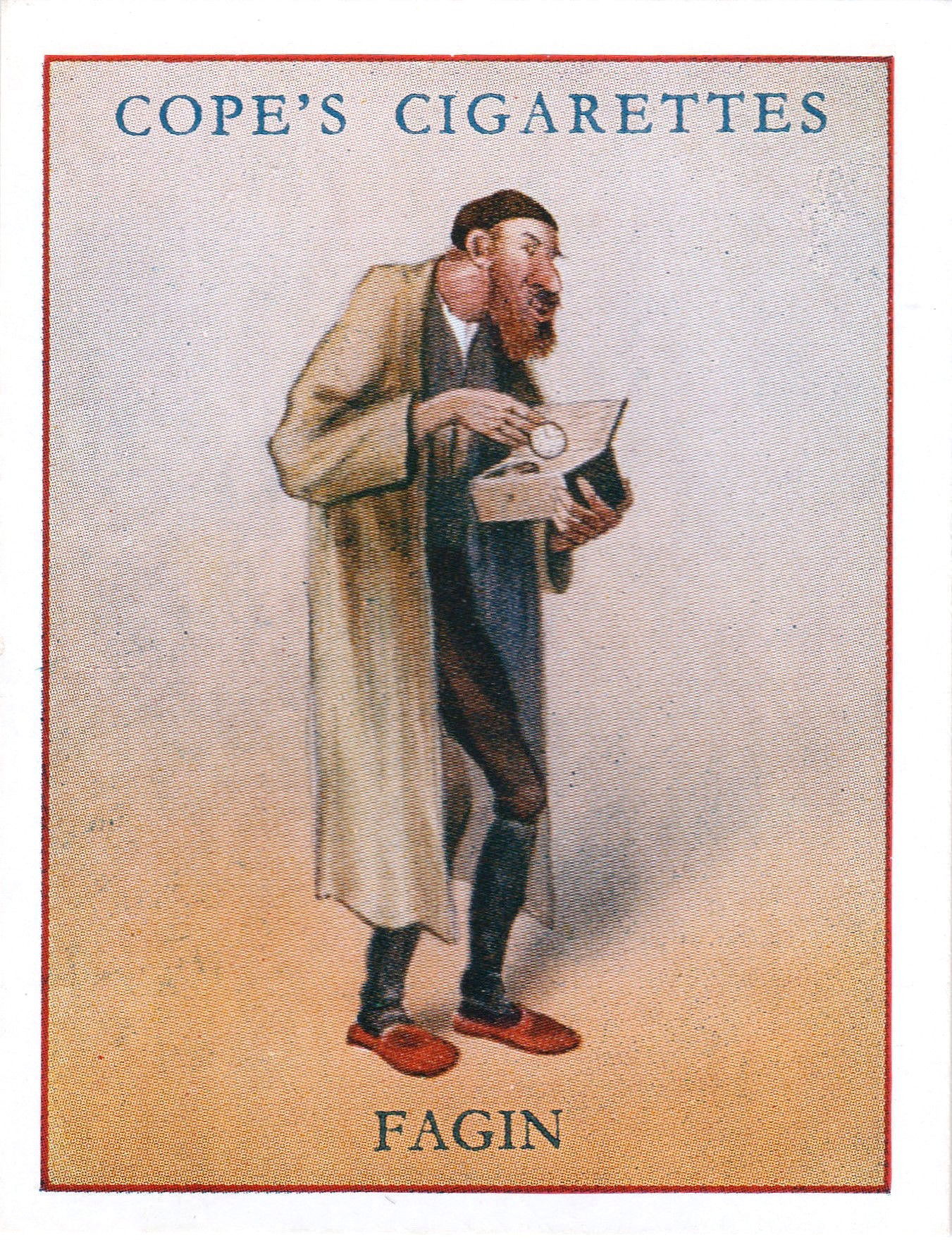
Card n.5 "DICKENS CHARACTERS SERIES "
COPE'S CIGARETTES (1939)
(Collezione personale)
The novel "Oliver Twist", Dickens' second novel, tells the story of an orphan who, having escaped from an orphanage, finds himself on the streets of London. Here, Oliver is recruited into a gang of young thieves led by the criminal Fagin. The book is famous for its strong social criticism, highlighting the harsh living conditions and exploitation of children in Victorian England.
The 1922 film remains faithful to the Dickensian text, managing to capture the essence of the characters and settings.
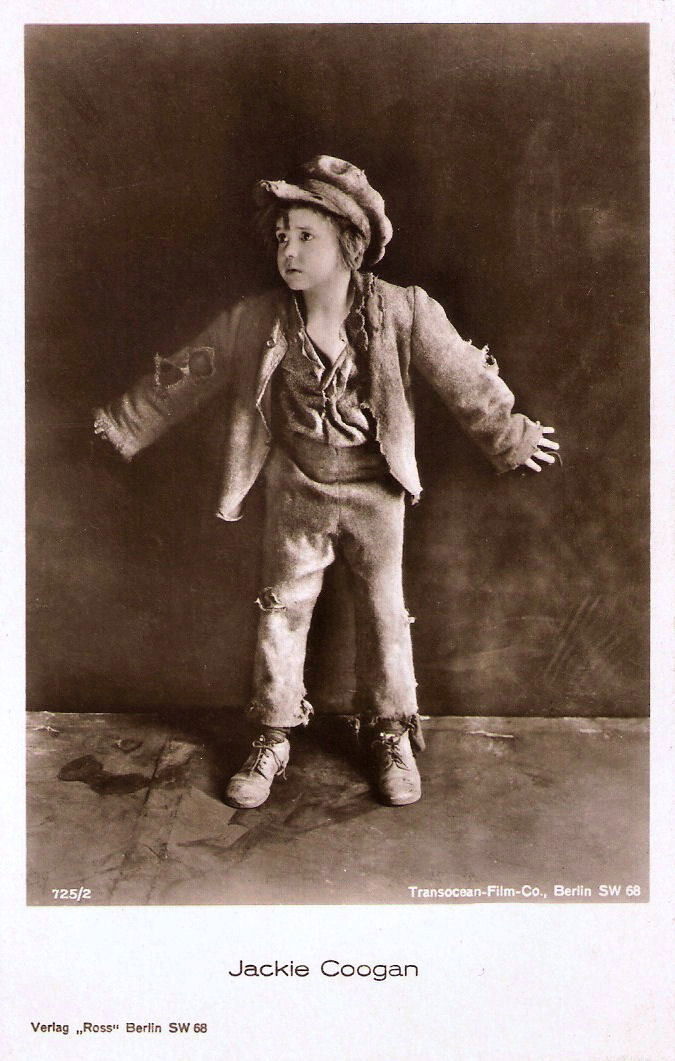
GERMAN POSTCARD "ROSS" n° 725/2
Jackie Coogan, already known for Chaplin's "The Kid", plays Oliver with great sensitivity, while Lon Chaney, "the man of a thousand faces", gives life to a Fagin that is both sinister and fascinating.

Card n.2 della serie "CHARACTERS FROM DICKENS"
JOHN PLAYER & SON (1912)
(Personal collection)
Unlike the novel, which uses a rich and detailed narrative, the film uses the expressions and gestures of the actors to communicate deep emotions. The intertitles keep the story adherent to the original, but it is the interpretation of the actors that makes the story tangible.
"Oliver Twist" from 1922 is a tribute to the timeless popularity of Dickens' novel. Even with the limitations of silent cinema, the film manages to convey the essence of the narrative and the complexity of its characters, demonstrating how visual power can match the written word.
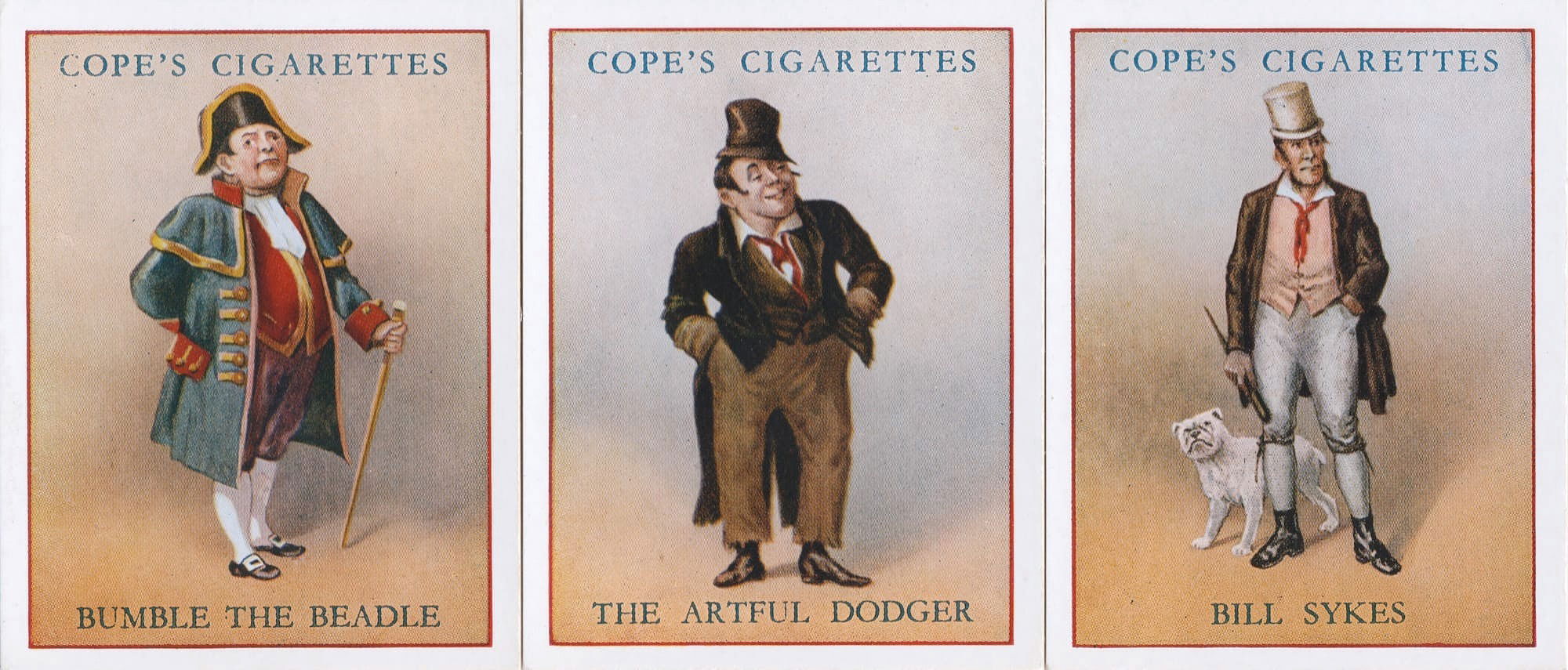
Cards n.2-3-4 "DICKENS CHARACTERS SERIES "
COPE'S CIGARETTES (1939)
(Personal collection)
The analysis of the intermediality between the 1922 film "Oliver Twist" and the homonymous work by Charles Dickens reveals a careful adaptation operation. Frank Lloyd's direction transformed the rich narrative fabric of the novel, published between 1837 and 1839, into a 74-minute visual experience. This synthesis required a careful selection of the most significant scenes and a simplification of the secondary plots, favoring moments of strong visual impact and drama, such as Oliver's escape from the orphanage and his encounter with the character of Fagin, to capture the viewer's attention in the absence of dialogue.
In addition, the film stands out for its intertextuality, drawing not only on Dickens' text but also on stylistic and visual elements typical of the time. The characterization of Fagin, played by Lon Chaney, is inspired by previous representations of the character, both theatrical and cinematographic, establishing a dialogue between different modes of expression and interpretations of the source material.
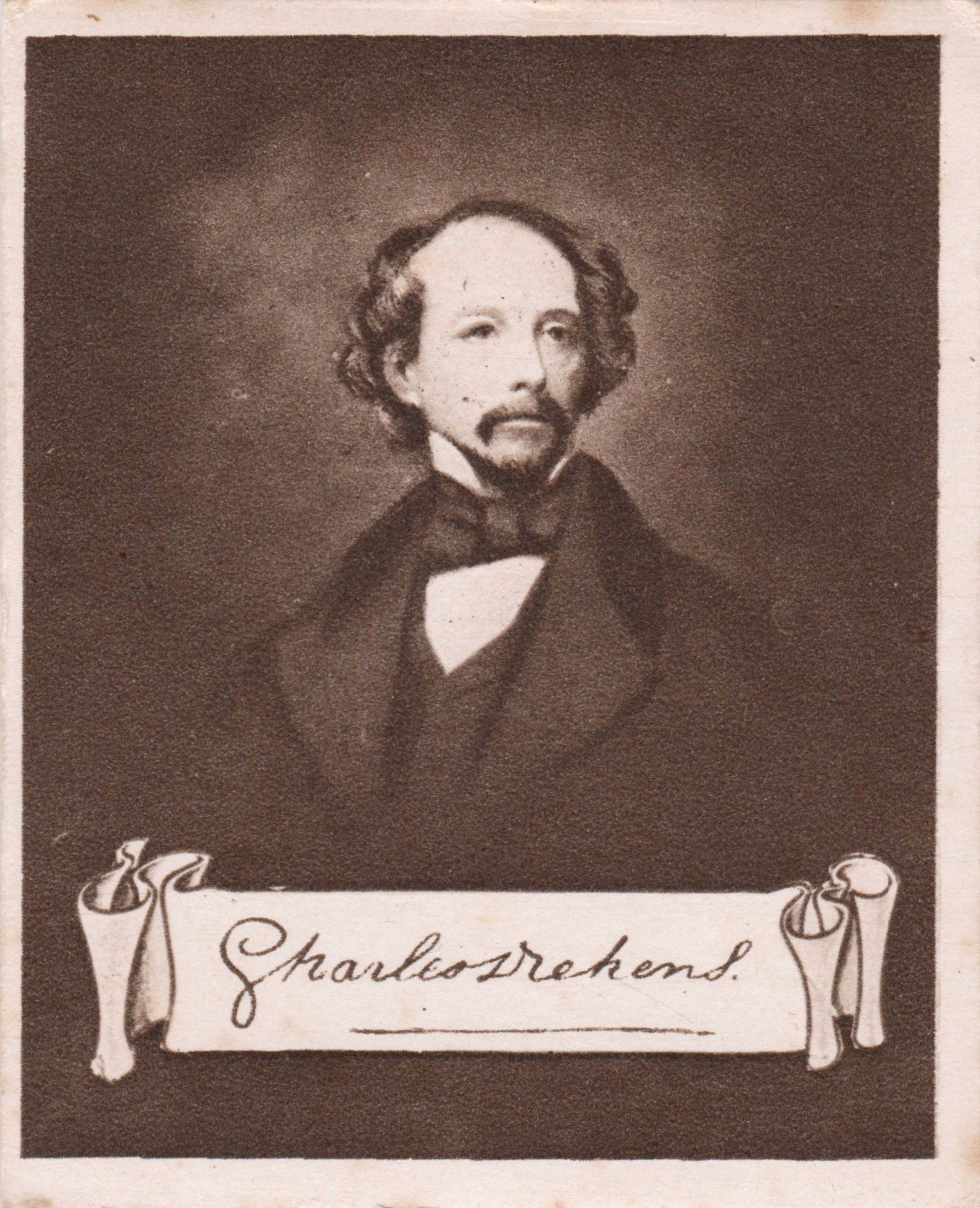
Card n.18 della serie "CELEBRITIES AND THEIR AUTOGRAPHS"
NICOLAS SARONY & CO. (1923)
(Personal collection)
The phenomenon of novelization, although not directly applicable to the 1922 film, is evidenced by the renewed interest in Dickens' novel that followed the success of the film. Later editions of the book have frequently included images from the film, consolidating a visual link that enriches the relationship between the literary text and its cinematographic adaptation.
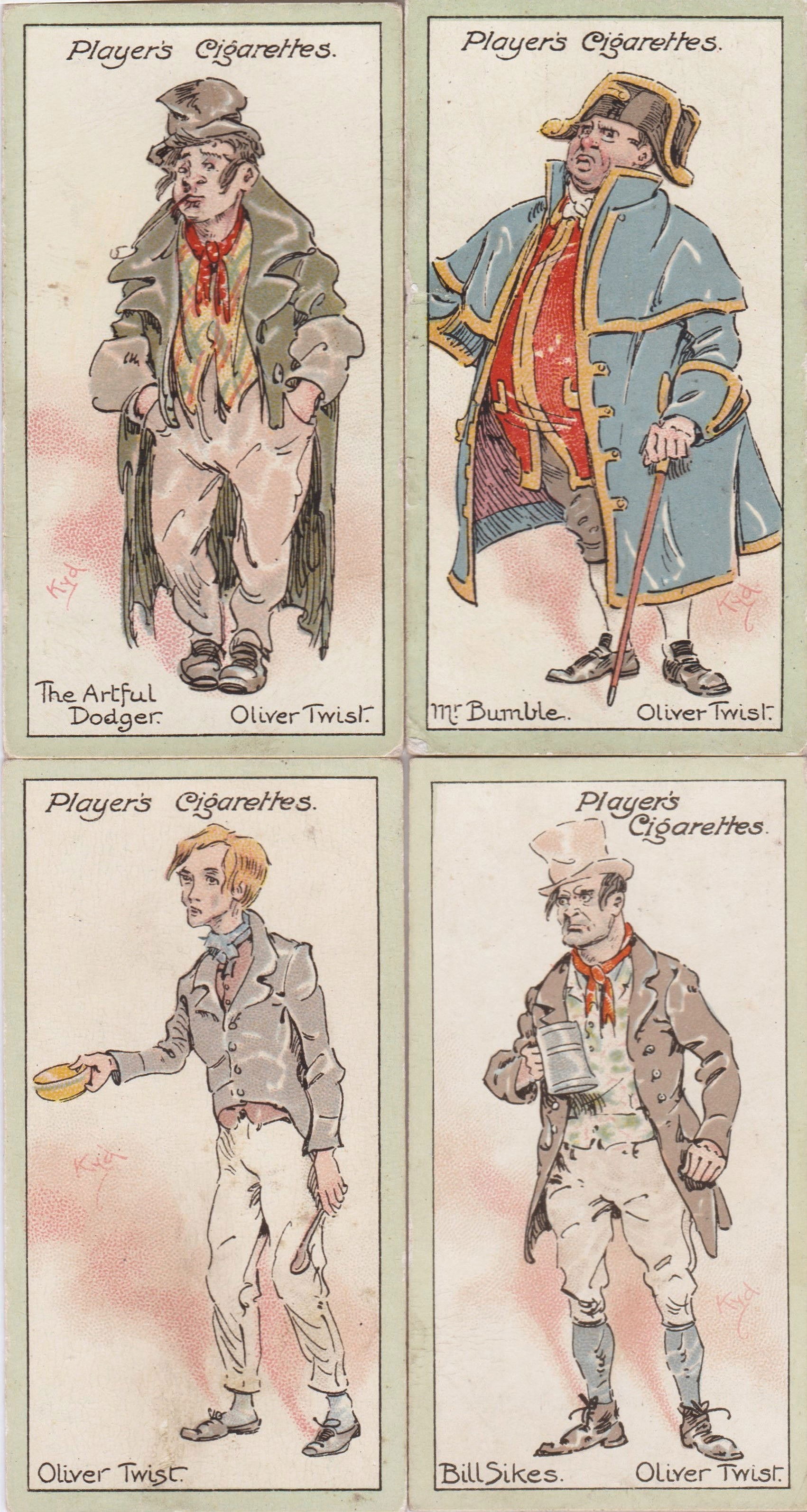
Cards n.1-2-4-9 della serie "CHARACTERS FROM DICKENS"
JOHN PLAYER & SON (1912)
(Personal Collection)
Finally, the intersemiotic translation carried out in the film is particularly evident in the conversion of Dickensi's meticulous descriptions into visual sequences. Victorian-era London, with its bustling streets and run-down neighborhoods, has been masterfully recreated through detailed sets and costumes faithful to the era, allowing viewers to "see" Dickens' words and immerse themselves in a more direct and concrete way in the author's narrative universe.
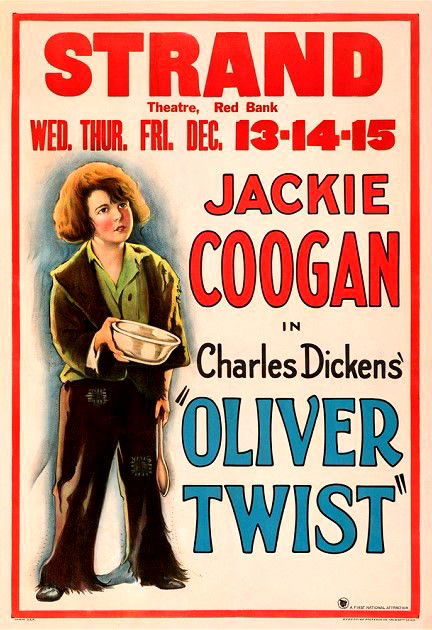
DOMBEY AND SON
Charles Dickens, one of the greatest writers in English literature, has seen many of his works adapted for the big screen. Among these, "Dombey and Son" has had an interesting cinematic path, with adaptations ranging from silent cinema to sound.
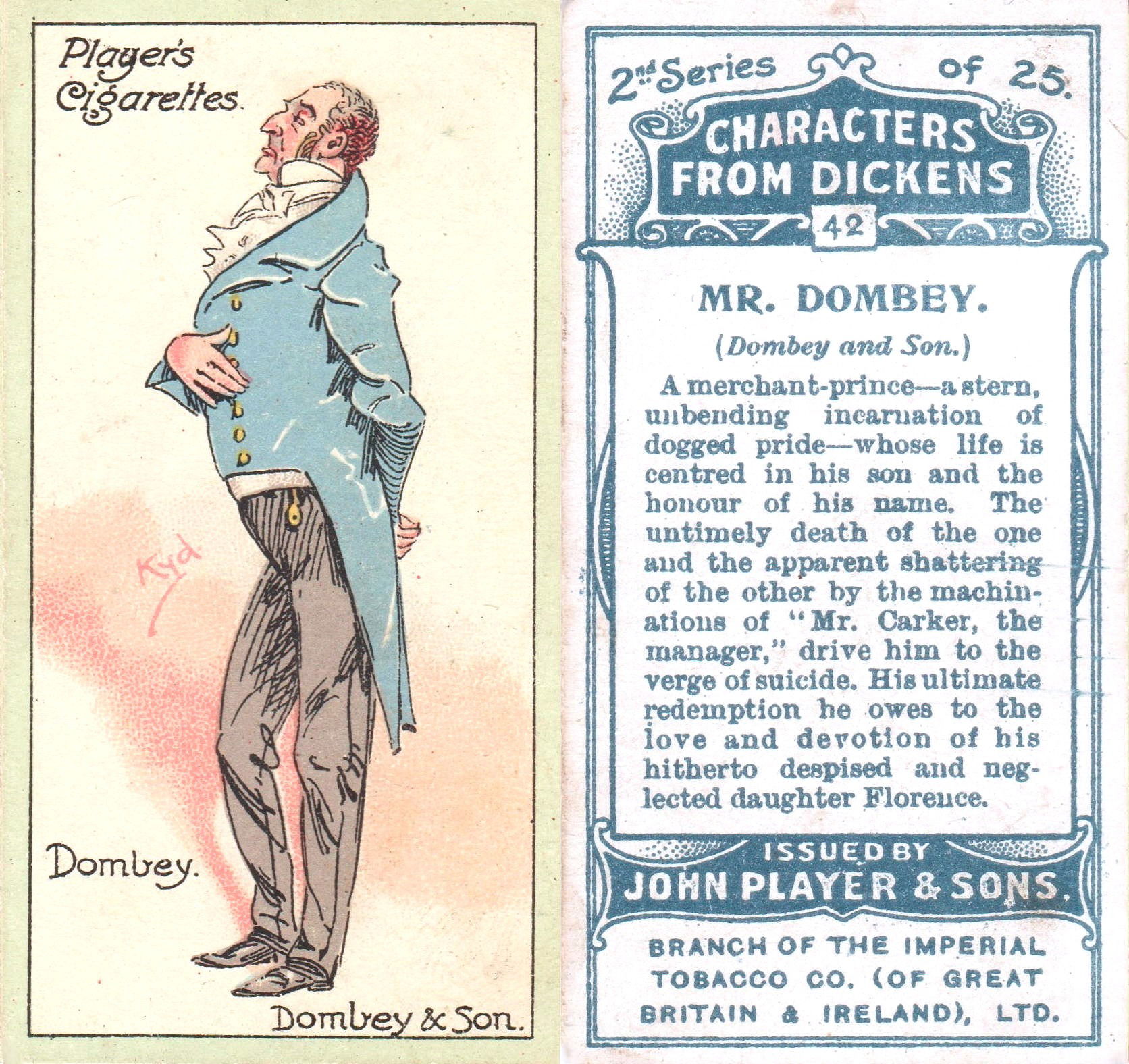
Card n.42 della serie "CHARACTERS FROM DICKENS" 2nd series
JOHN PLAYER & SON (1912)
(Personal collection)
Published between 1846 and 1848, "Dombey and Son" tells the story of Paul Dombey, a wealthy owner of a shipping company, obsessed with the idea of having a son to continue his business. The novel explores themes such as pride, social inequality and family dynamics, with a particular focus on the relationship between Dombey and his daughter Florence, who is neglected by her father.
The first significant film adaptation of the novel was the 1917 British silent film, directed by Maurice Elvey. This film tried to stay true to the complex plot of the novel, despite the limitations of silent cinema. The lead actors included Norman McKinnel as Paul Dombey and Lilian Braithwaite as Edith Dombey. The visual storytelling and intertitles were key to conveying the emotional depth and themes of the novel.
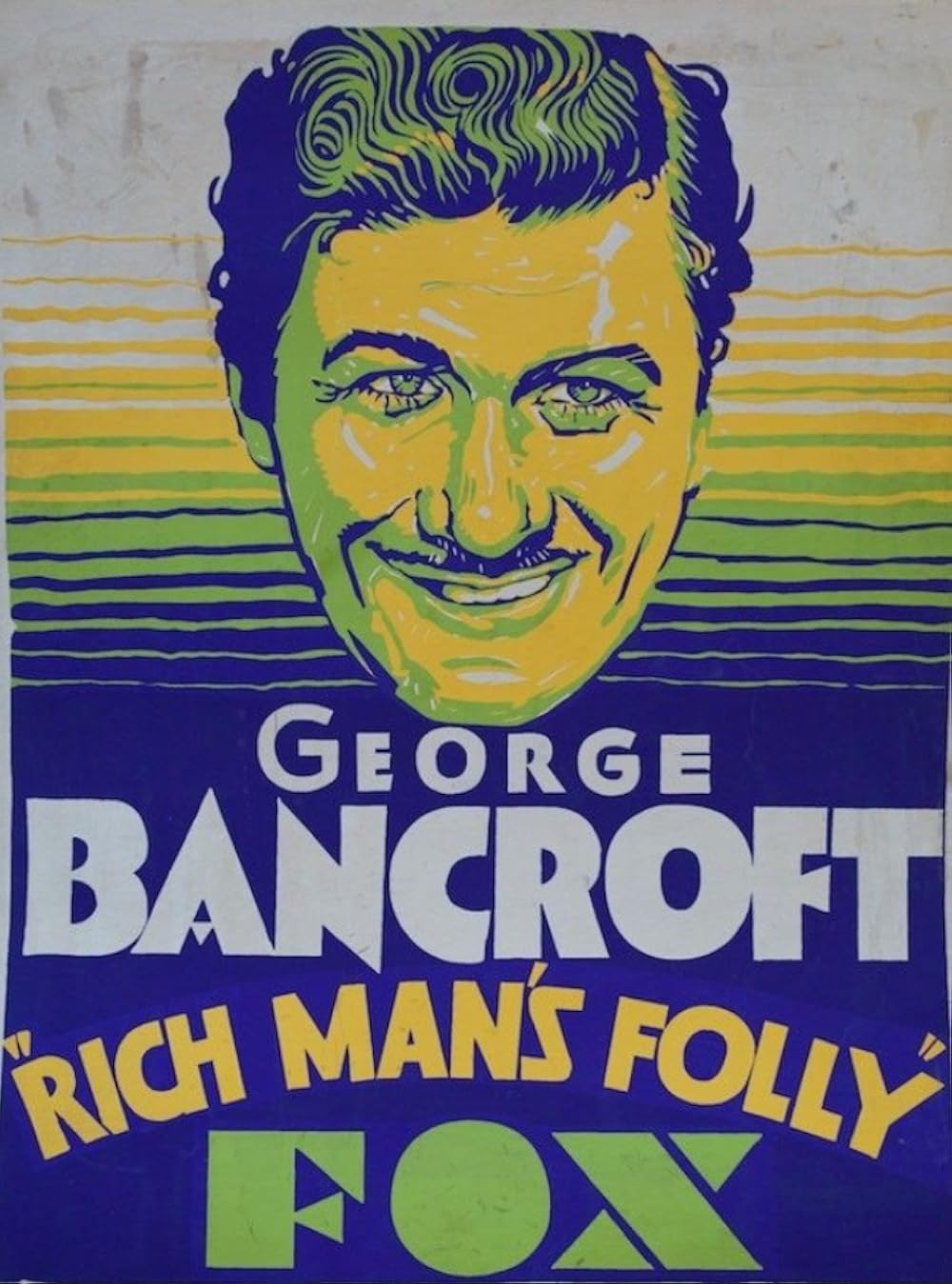
FILM POSTER
"Rich Man's Folly" is a modern adaptation of the novel "Dombey and Son", directed by John Cromwell. This 1931 film transposed Dickens' story into a contemporary context, maintaining the central themes of the novel. George Bancroft played the lead role, renamed Brock Trumbull, an industry mogul obsessed with having a son to continue his business. The film sought to modernize the story, making it more accessible to audiences at the time, but maintaining the essence of Dickens' social criticism.

Card n.22 della serie "DICKENS CHARACTER SERIES" (1939) e Card della serie "CHARACTERS FROM DICKENS" EXTRA LARGE
JOHN PLAYER & SON (1912)
(Personal collection)
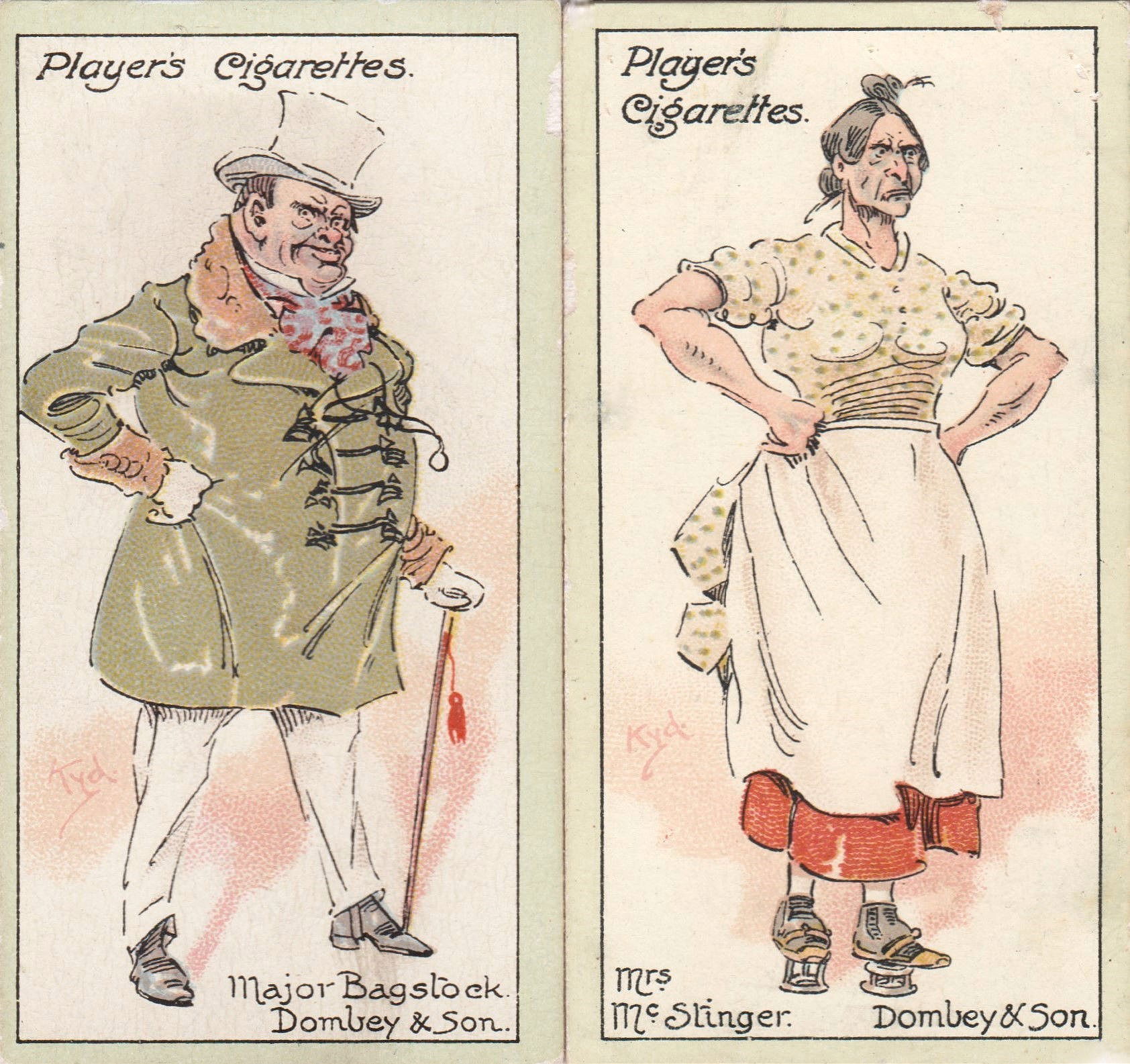
Card n.7 of the series "CHARACTERS FROM DICKENS" and Card n.43 of the second series
JOHN PLAYER & SON (1912)
(Personal collection)
In the 1931 film "Rich Man's Folly," the character based on Captain Cuttle is portrayed by Harry Allen. However, the character's name has been changed to McWylie, while the character of Major Bagstock and Mrs. Mac Stinger are not present. This modern adaptation of Charles Dickens' novel "Dombey and Son" has made several changes to the characters' names and characteristics to better fit the context of the film.

Card n.5 "DICKENS CHARACTERS SERIES
"COPE'S CIGARETTES (1939)
(Personal collection)
Another curious minor character excluded from the film is The Game Chicken, a professional boxer and Mr. Toots' boxing instructor. Despite his limited role, the character adds a touch of color and authenticity to the world created by Dickens, representing the popular and sporting culture of the time.
All three works explore themes of pride, social inequality, and family dynamics. The figure of the authoritarian father and his obsession with a male heir are central elements in all versions. The 1917 film tried to stay true to the original novel, while 1931's "Rich Man's Folly" modernized the story, adapting it to contemporary times while keeping the main themes. The transition from the silent film of 1917 to the sound film of 1931 shows the evolution of cinema and how narrative techniques have adapted to maintain the essence of Dickens' stories.
The adaptation of "Dombey and Son" in cinema, from the 1917 silent film to the 1931 "Rich Man's Folly", represents a fascinating journey through the evolution of cinema and the continuing relevance of Dickens' works. Each version brought something unique, demonstrating how the novel's universal themes can be reinterpreted and modernized to resonate with audiences from different eras.
LITTLE DORRITT
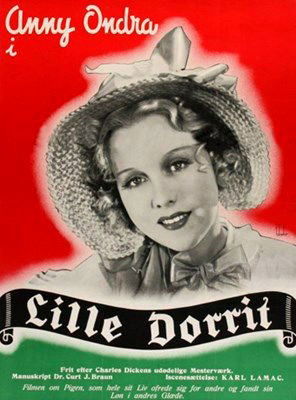
MOVIE POSTER
The 1934 film "Klein Dorrit" is a film adaptation of Charles Dickens' novel "Little Dorrit," which offers a visual depiction of Amy Dorrit's life and her vicissitudes in the Marshalsea debtors' prison. This film, directed by Karel Lamač, stands out for its fidelity to the original text and for its ability to capture the essence of Dickensian characters.

GERMAN POSTCARD n° 588
Dickens' novel, published in installments between 1855 and 1857, is an incisive critique of the social and economic structures of Victorian England, highlighting the injustices of the legal system of the time, in particular the institution of prisons for debtors. The story of Amy, who was born and raised in prison, and Arthur Clennam, who returns to England after twenty years in China, is a profound exploration of the class dynamics and economic difficulties that afflict the characters. The film adaptation enriches the narrative with a visual dimension that emphasizes the emotions and relationships between the characters, while maintaining the social criticism of the novel.
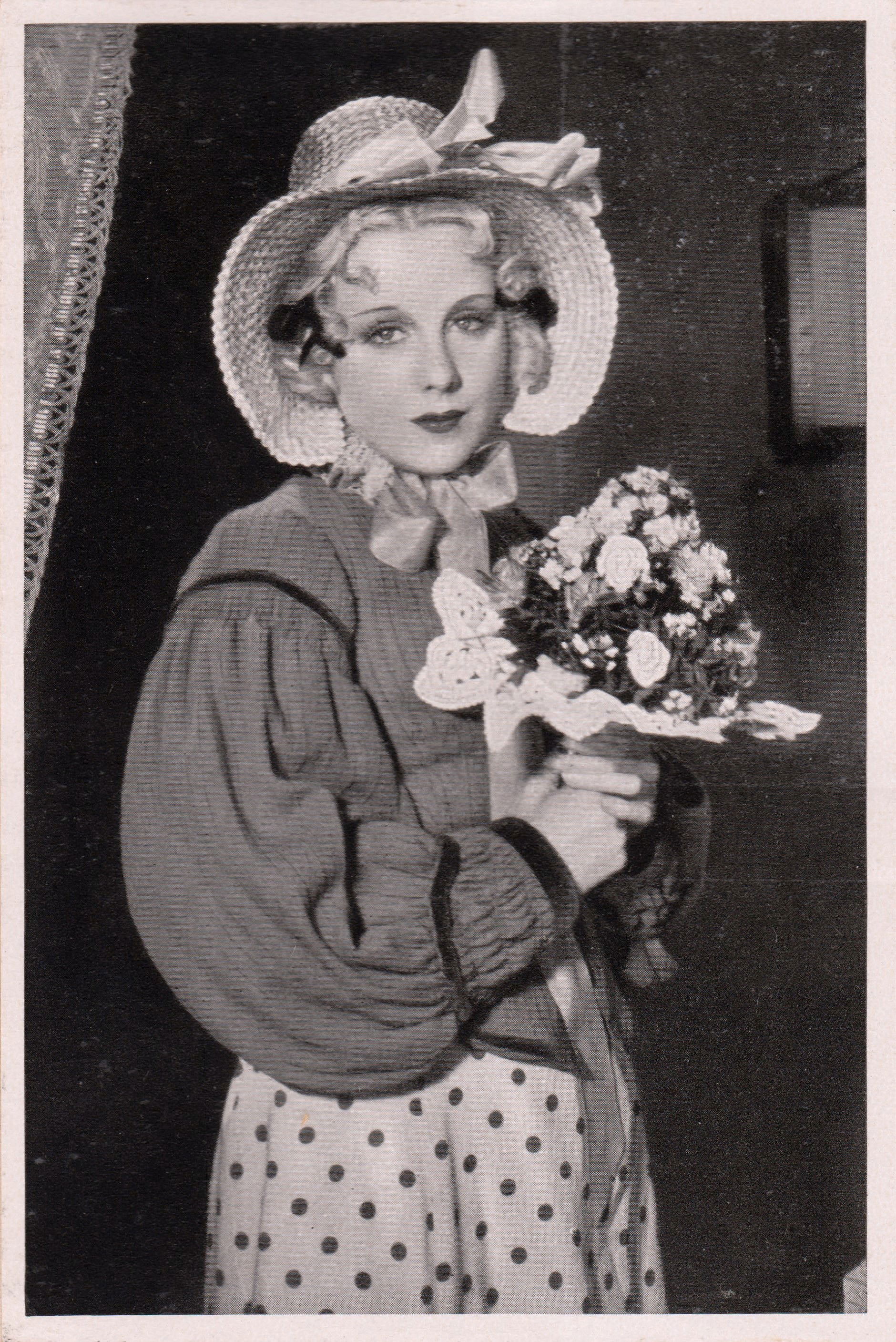
ANNY ONDRA as Amy Dorrit
Card position n.1 pag. 44
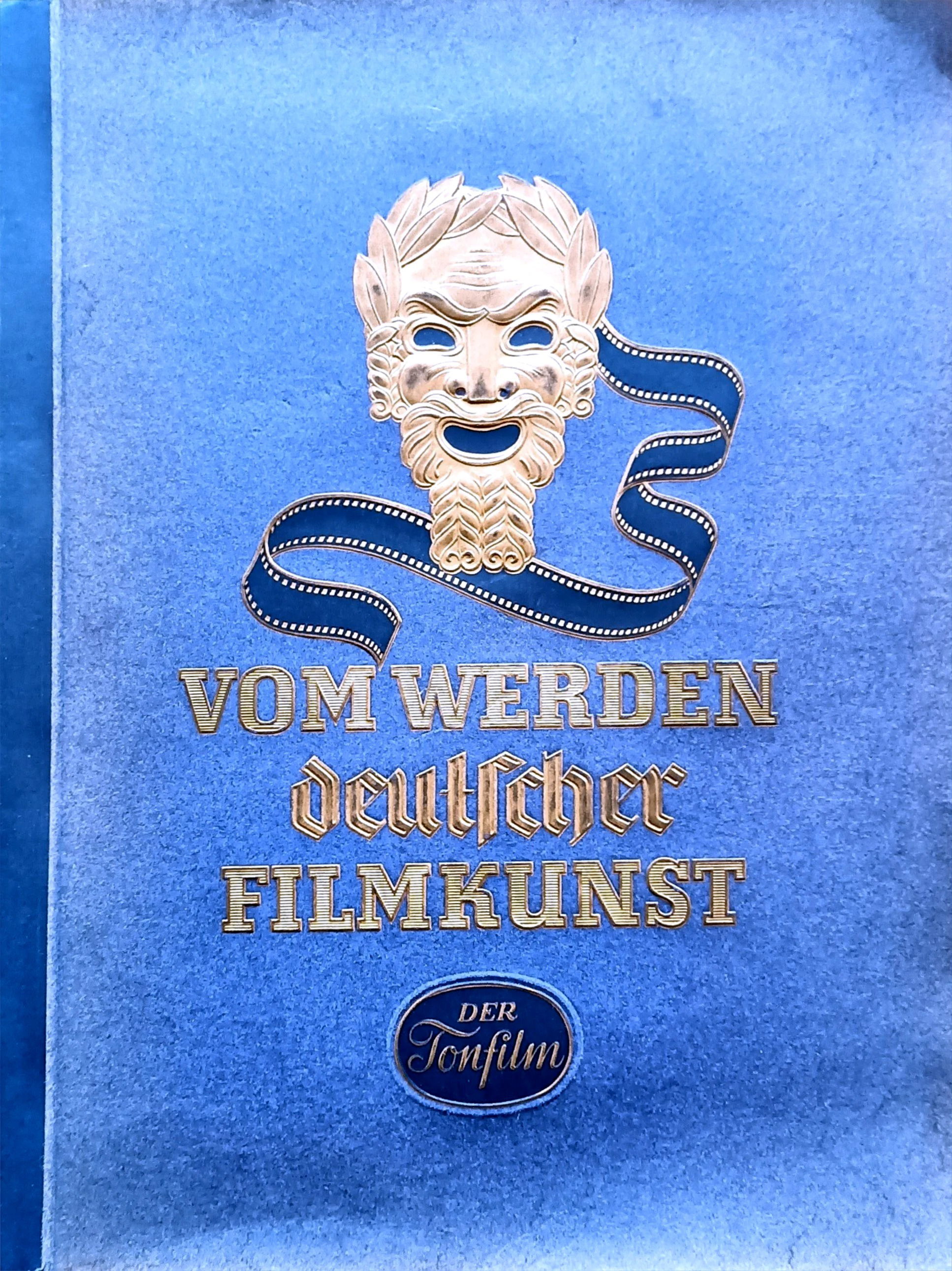
(Personal collection)
Before the 1934 film "Klein Dorrit", there were other film adaptations of Charles Dickens' novel "Little Dorrit". Although information is limited, it is known that film versions existed as early as 1913 and 1920. These films, unfortunately, are not as widely recognized or available as newer releases, which makes detailed analysis of their content or cultural impact difficult. However, the fact that "Little Dorrit" was adapted for the screen so soon after its publication is testament to the novel's lasting impact and popularity. These older, though lesser-known, adaptations helped establish a tradition of transposing Dickens' works into film, a practice that continues to the present day.
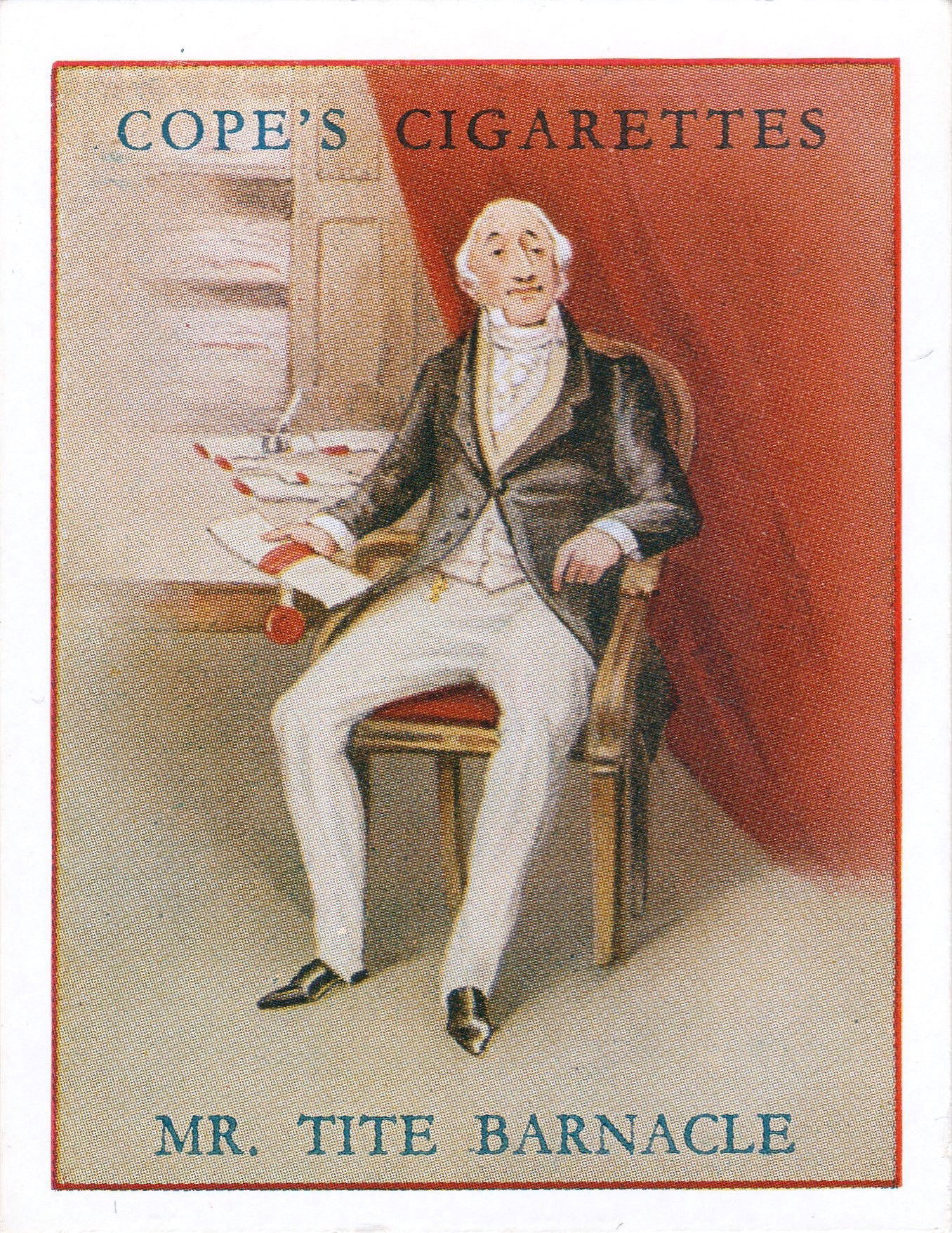
Card n.1 "DICKENS CHARACTERS SERIES
"COPE'S CIGARETTES (1939)
(Personal collection)
The character of Tite Barnacle, who in Charles Dickens' novel represents a bureaucrat of the Circumlocution Office, was not included in the film adaptation. This is quite common in film adaptations of literary works, where some characters or subplots are omitted for reasons of time or to simplify the story.
DAVID COPPERFIELD
The transformation of "David Copperfield", Charles Dickens' literary masterpiece, into a film is a fascinating journey that spans two centuries of art history. The novella, first published in 1850, has been adapted countless times for the screen.

Cards n.14 "FIGURES OF FICTION"
LTD RACING (1924)
(Personal collection)
The 1935 film "David Copperfield" is a cinematic work that deserves a special mention for its faithful depiction of Charles Dickens' classic. Directed by George Cukor and produced by David O. Selznick, this adaptation is often praised for its ability to capture the essence of the original novel despite some omissions.

Card n.7 - FAMOUS FILM SCENES
GALLAHER Ltd (1935)
(Personal collection)
The film stands out for its memorable performances, including that of W.C. Fields as Mr. Micawber and Freddie Bartholomew as the young David. The film was a success with both critics and audiences, cementing its place in film history as one of the most successful adaptations of a Dickens work.
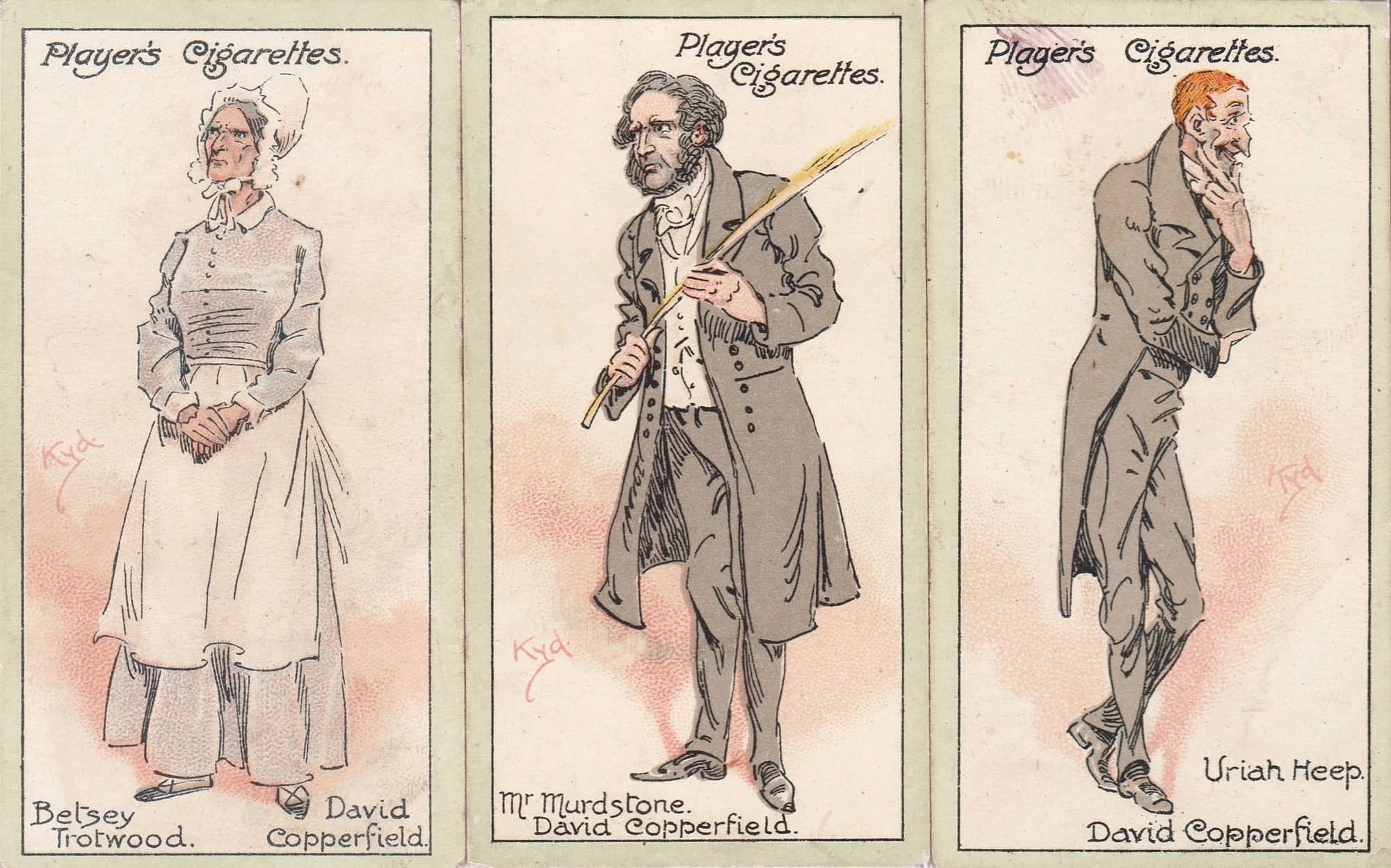
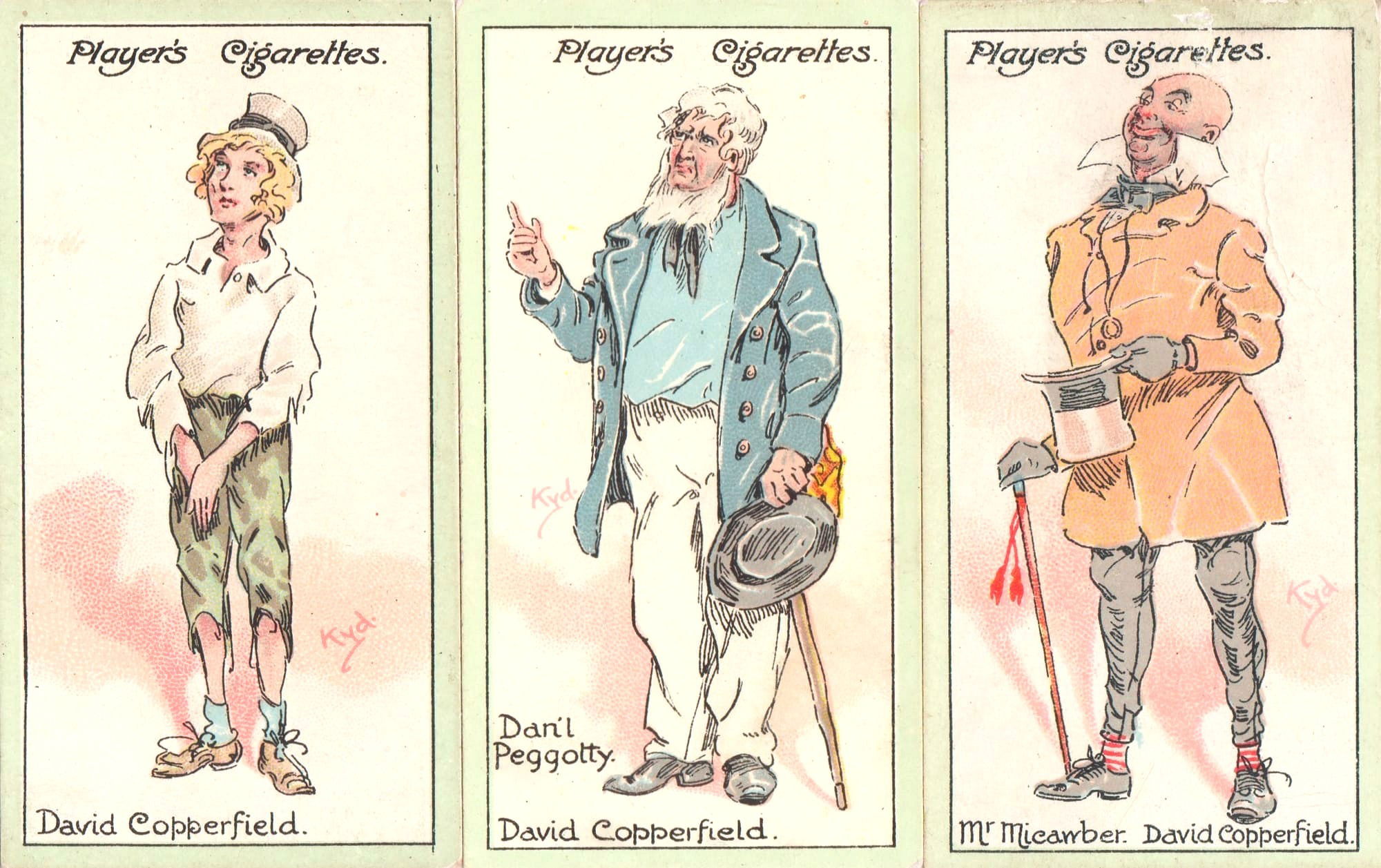
Cards dalla n.36 alla 41 della serie "CHARACTERS FROM DICKENS" 2nd series
JOHN PLAYER & SON (1912)
(Personal collection)
The screenplay, written by Hugh Walpole and Howard Estabrook, has been able to masterfully transpose the events of the young David Copperfield, from his troubled childhood to maturity. Cukor's direction emphasized the emotional depth and complexity of the characters, key elements of the novel. Oliver T. Marsh's black and white photography helps to create an atmosphere that reflects the Victorian era in which the story is set.
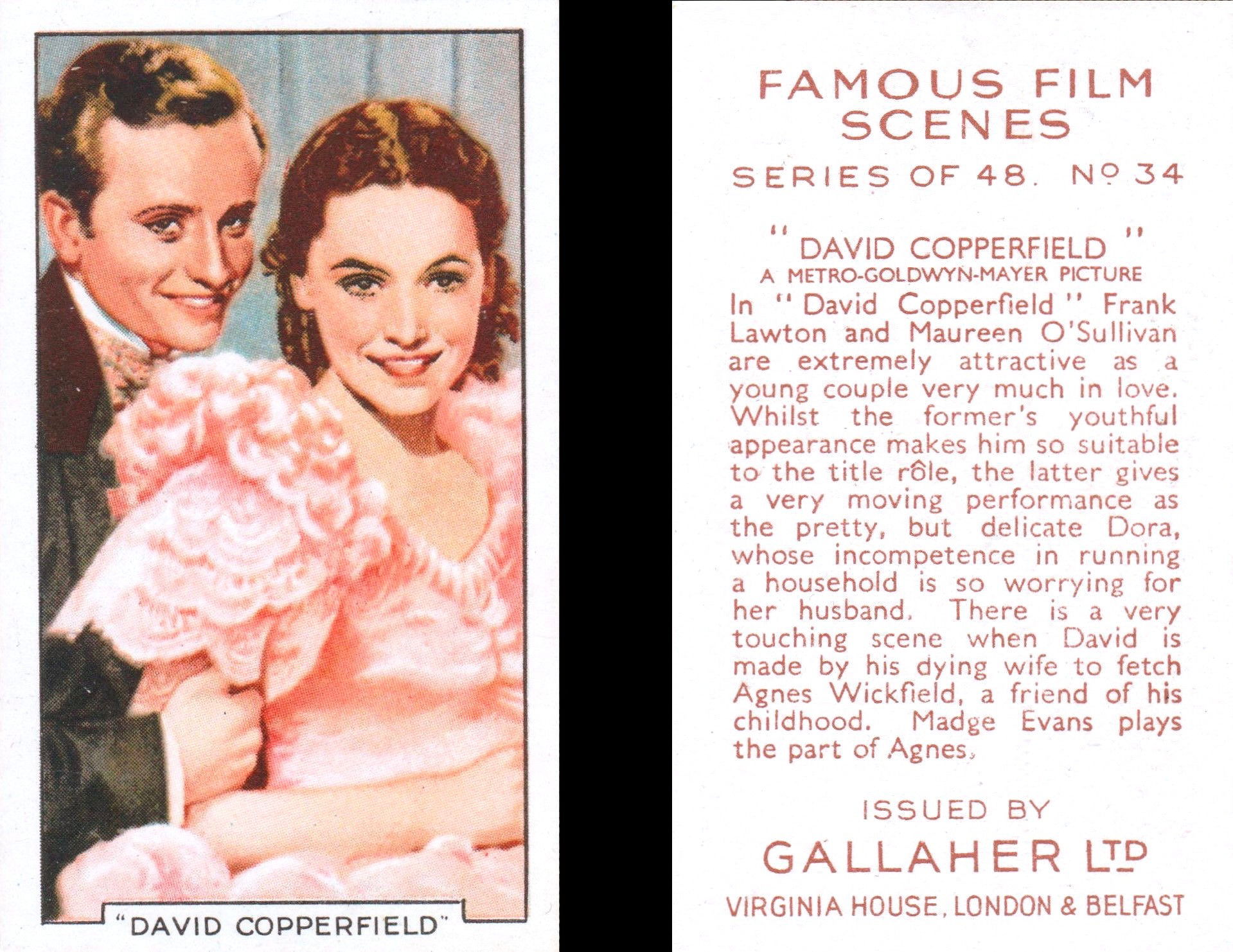
Card n.7 - FAMOUS FILM SCENES
GALLAHER Ltd (1935)
(Personal collection)
The film's star-studded cast also includes Lionel Barrymore, Madge Evans and Maureen O'Sullivan, who brought the characters to life with great authenticity and passion. Barrymore's performance as Dan Peggotty is particularly touching, managing to convey the goodness and strength of the character. The artistic direction of Cedric Gibbons and the scenography of Merrill Pye have carefully recreated the environments described by Dickens, immersing the viewer in nineteenth-century England.
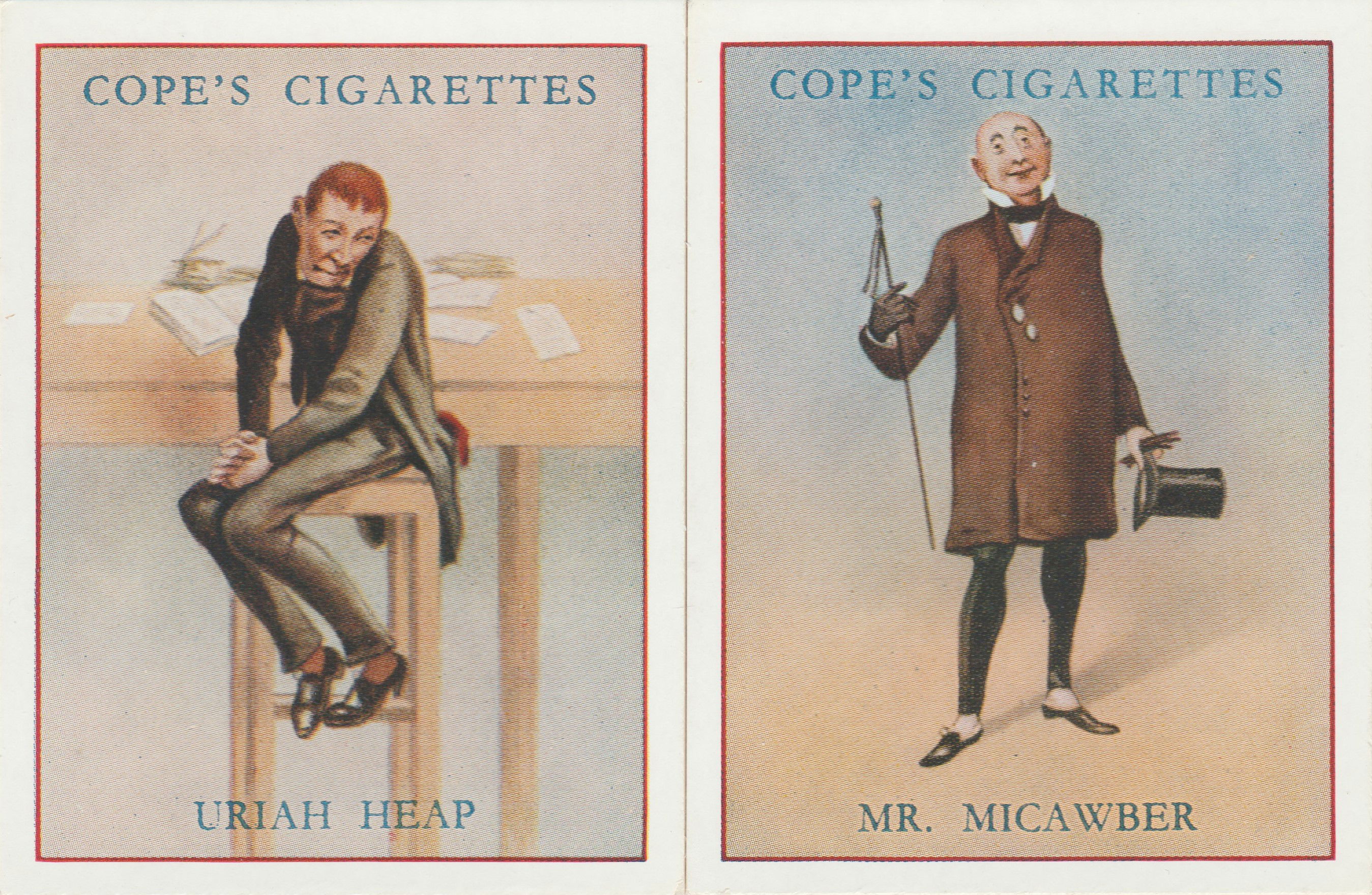
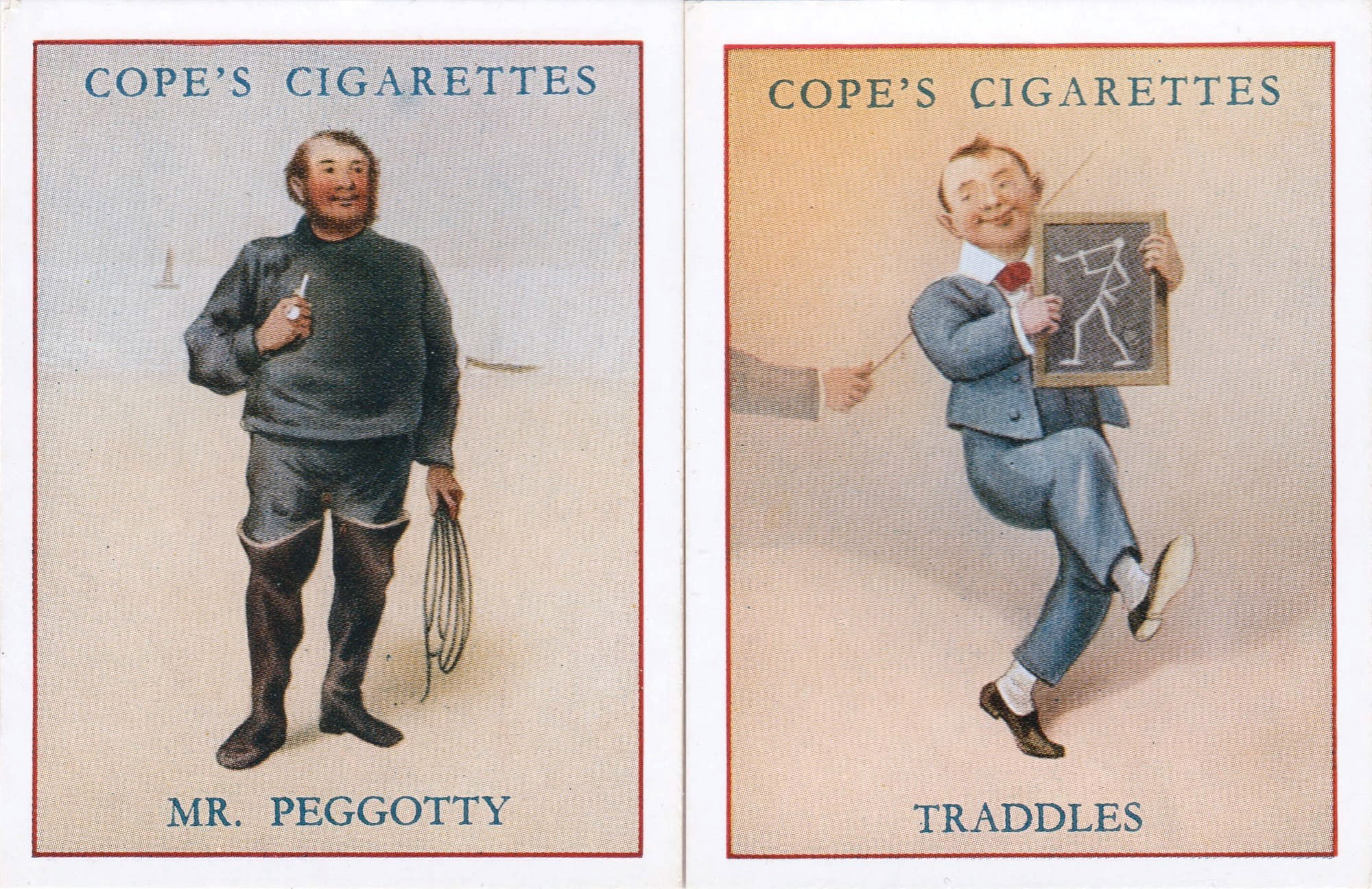
Cards 8-9-10-11 "DICKENS CHARACTERS SERIES "
COPE'S CIGARETTES (1939)
(Personal collection)
Despite some differences from the literary source, such as the omission of some characters to maintain a reasonable running time, the film managed to convey the spirit of the book. W.C. Fields, who played the role of Wilkins Micawber, responded to criticism of his strong American accent by jokingly stating that he had inherited the accent from his English father. Fields was also an avid real-life scholar of Dickens, which adds a layer of authenticity to his interpretation.
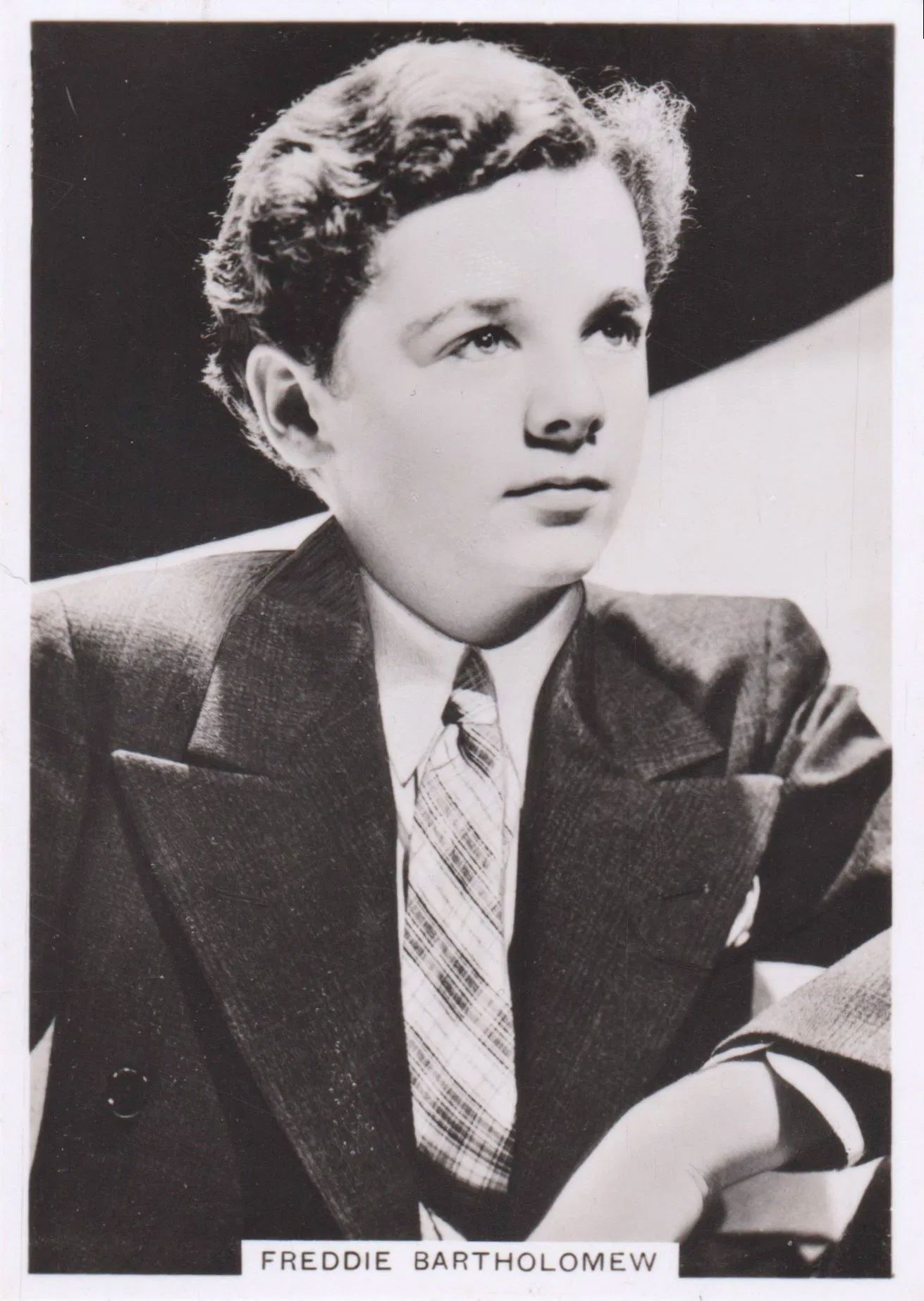
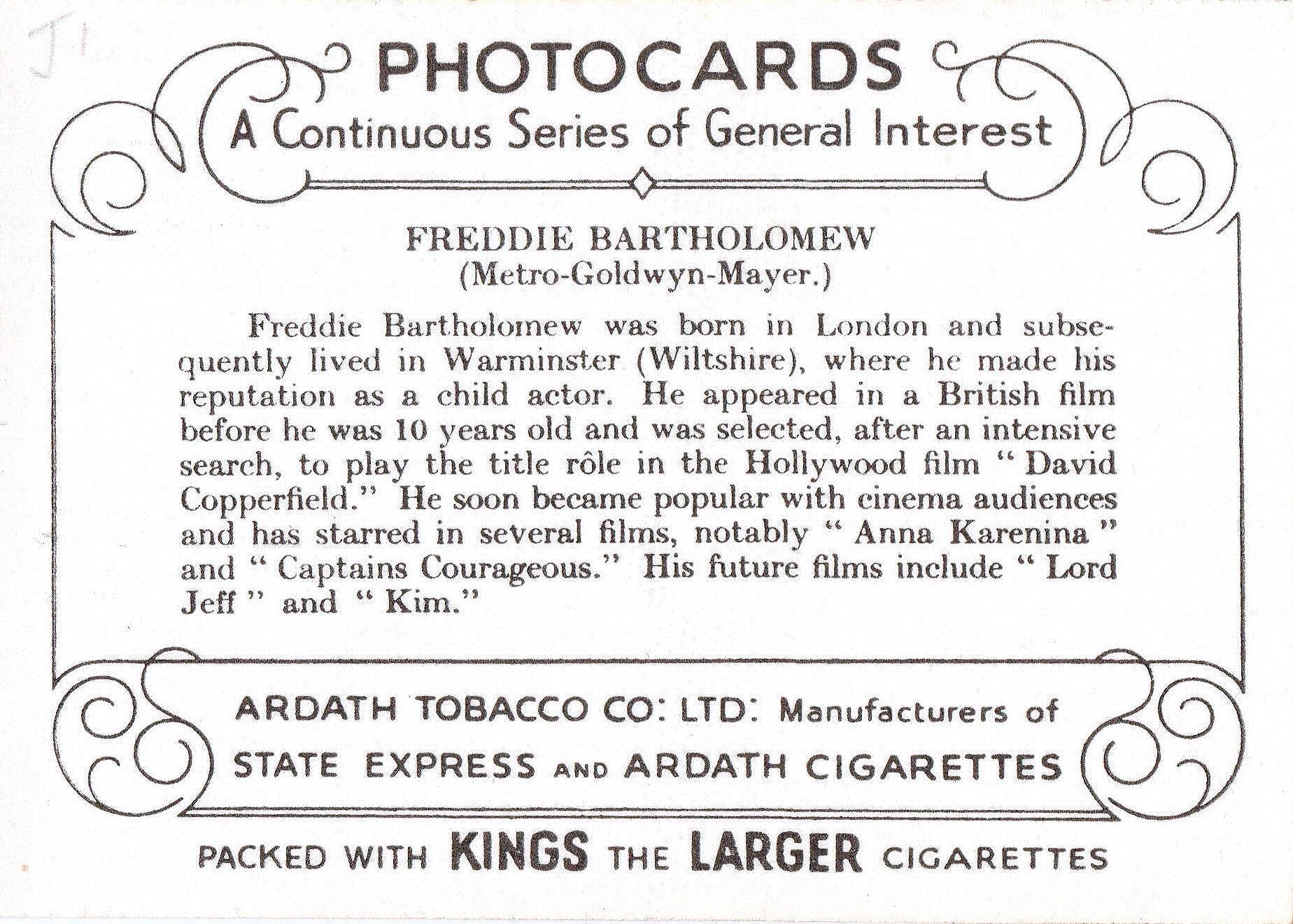
Card della serie PHOTOCARDS (GROUP J)
ARDATH TOBACCO CO LTD (1939)
(Personal collection)
Freddie Bartholomew, who played young David, became one of Hollywood's highest-paid child actors thanks to the success of this film and "Captains Courageous" (1937), earning a weekly wage of $2,500, second only to star Shirley Temple. The performance of the cast, along with the costumes and cinematography, helps to create an atmosphere that transports the viewer back in time, offering a rich and immersive cinematic experience.
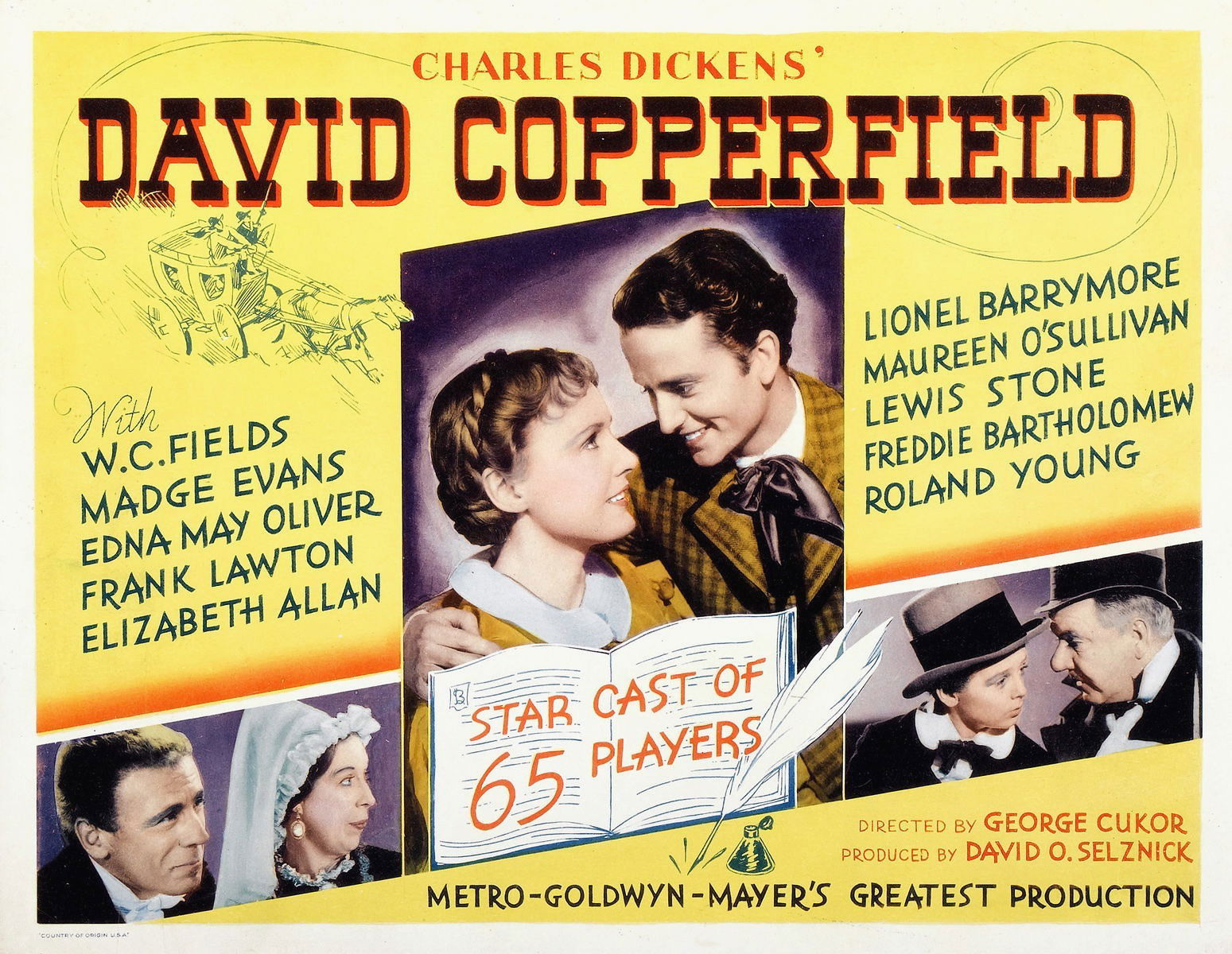
MOVIE POSTER (1935)
"David Copperfield" remains a significant film that continues to be appreciated for its ability to tell a story of personal growth and overcoming adversity with sensitivity and depth. This film laid the foundations for future transpositions of literary classics, showing that visual storytelling can enrich and amplify stories told through words.
David Copperfield of 1935 is not just a film adaptation of a novel, but a work of art that rightfully stands alongside Dickens' text. With its attention to detail, stunning performances, and sensitive direction, the film continues to be a benchmark for film adaptations and a shining example of how cinema can honor and perpetuate classic literature.
NICHOLAS NICKLEBY

FILM POSTER
The 1947 film adaptation of "The Life and Adventures of Nicholas Nickleby" represents a turning point in the history of literary cinema, marking the transition from silent to sound in the transpositions of Dickens' works. The direction of Alberto Cavalcanti and the screenplay of John Dighton have been able to transfer the complexity of Dickensian characters and themes to the big screen with a fidelity that does not sacrifice the originality of the interpretation.
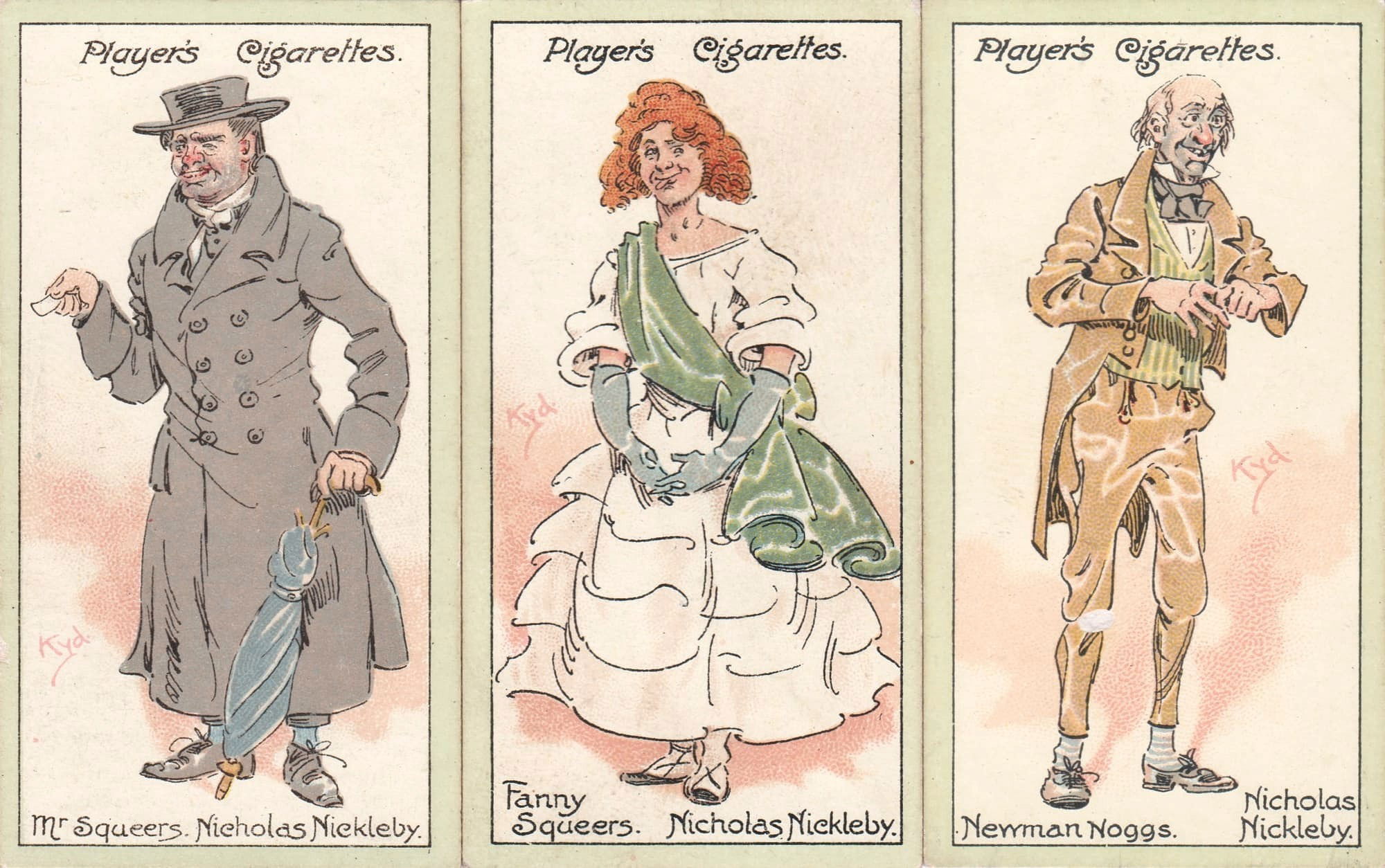
Cards dalla n.44 alla 46 della serie "CHARACTERS FROM DICKENS" 2nd series
JOHN PLAYER & SON (1912)
(Personal collection)
The film stands out for its ability to capture the essence of the novel, presenting a narrative that, while being faithful to the literary work, has been adapted to make the most of the expressive potential of cinema.
Derek Bond's performance as the title character Nicholas and Cedric Hardwicke's performance as Uncle Ralph was particularly praised for their intensity and ability to convey the emotional complexity of their characters. The film effectively explores the themes of social injustice and corruption, as well as the search for redemption, central elements in Dickens' work.
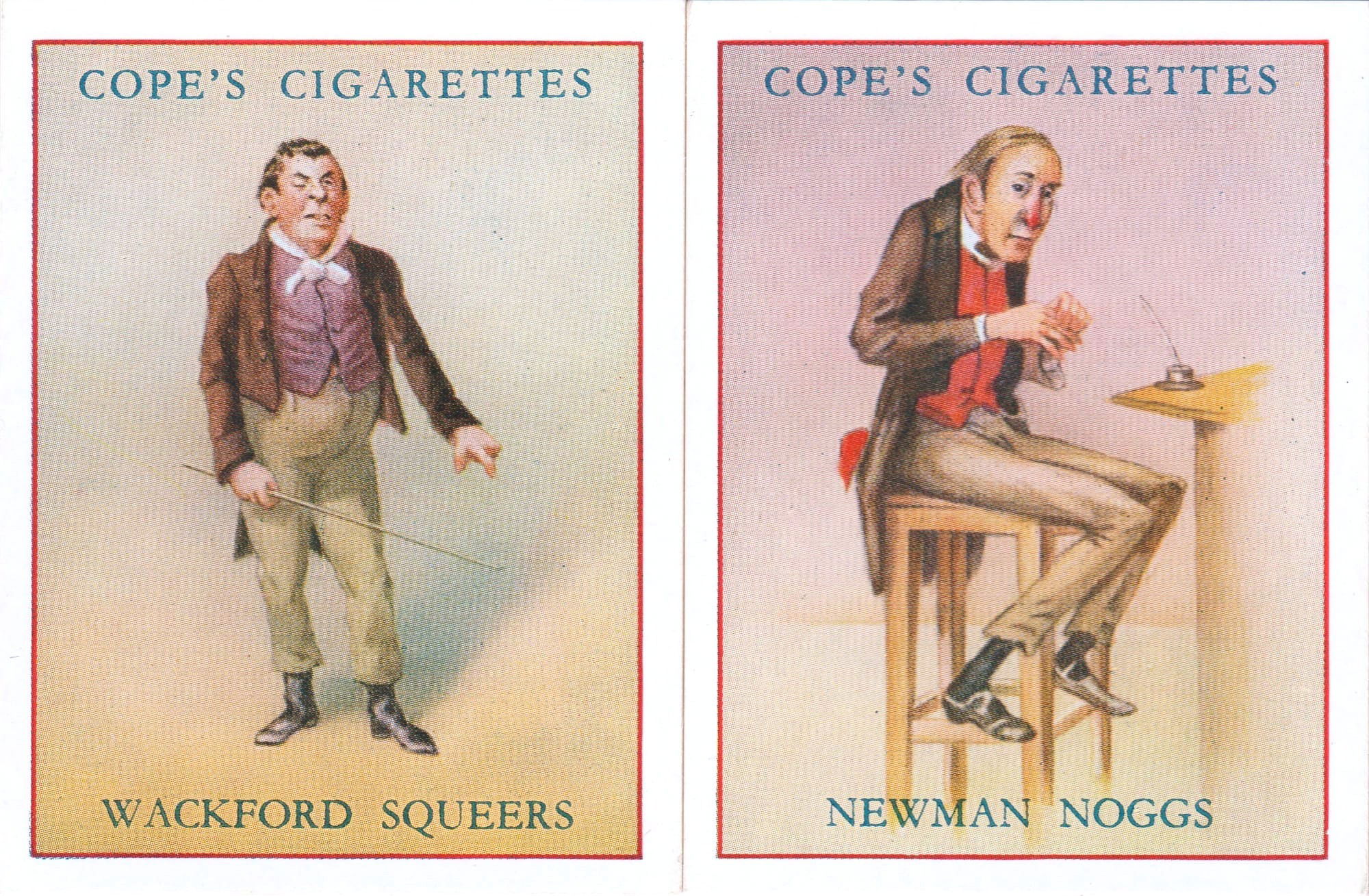
Cards 19-20 "DICKENS CHARACTERS SERIES "
COPE'S CIGARETTES (1939)
(Personal collection)
